Come with me as I repair and service this absolutely incredible Sansui G-8000 receiver. Guess what folks – she’s for sale 😉
Actually, you might call this a minor overhaul and you heard me right – I can hardly believe it but this Sansui G-8000 is mine, now works perfectly and she is for sale, details in the Store.
UPDATE: Sold! Keep reading for details.
Background
This is an amazing story, but briefly, this Sansui G-8000 monster receiver was owned by her original owner, my customer, from new. This gentleman has been a customer for a long time and I originally worked on this old girl seven years ago, servicing her, undoing the effects of some other work that had been done before I saw her and getting her running sweetly.
And sweetly she ran, for the next seven years, despite needing a freshen-up back then, as noted in my original invoice. And then, just a couple of weeks ago at the time of writing, her owner contacted me again to discuss having a service and some other work done.
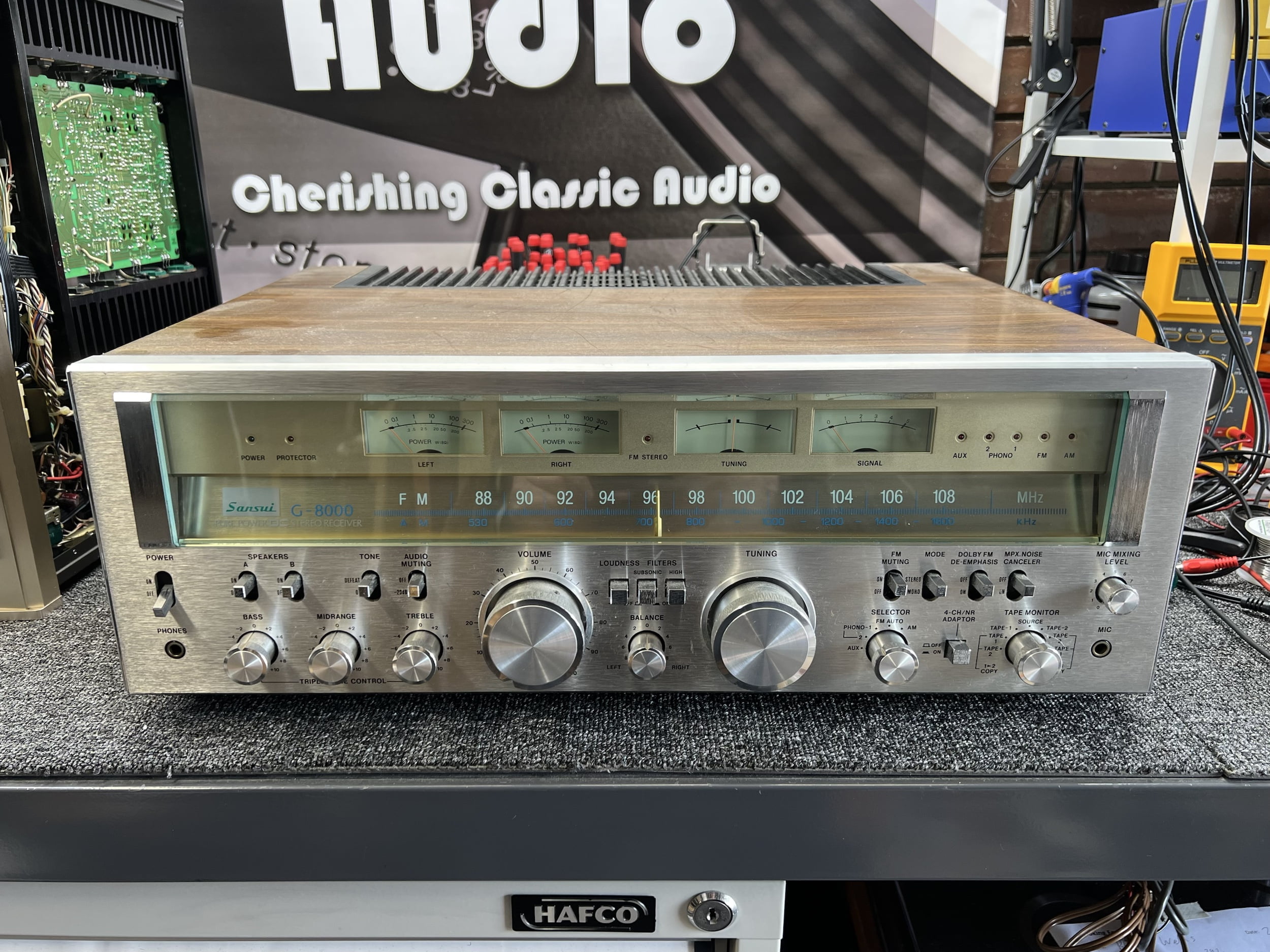
I explained that an overhaul was a good idea and that at least some deep maintenance would be needed. Now, I don’t know why, but he suddenly changed his mind about fixing her, deciding that he didn’t want to spend any money on her at all, even if it might not be very much.
Naturally, I explained that it would be sensible to see what she needed before getting rid of her, but the owner wasn’t interested. He told me he wanted her gone, didn’t want to spend a cent more on her and that he was either going to THROW HER IN THE BIN, or give her to me! The bin???? What???!!!
Naturally, I implored him not to throw her away and tried to convince him to at least let me investigate. I explained that I could repair her and then let him know what it cost. Not interested. Finally, I offered him a small amount of money to own the old girl, issues unknown and save her from that bin.
Even then, after paying him, I said I would offer the Sansui G-8000 to him once I repaired her, but he wasn’t interested. Perhaps he was just happy to let her go to someone he knew would take good care of her. So that’s how we got here. Now, it’s time to fix her and find her a new home…
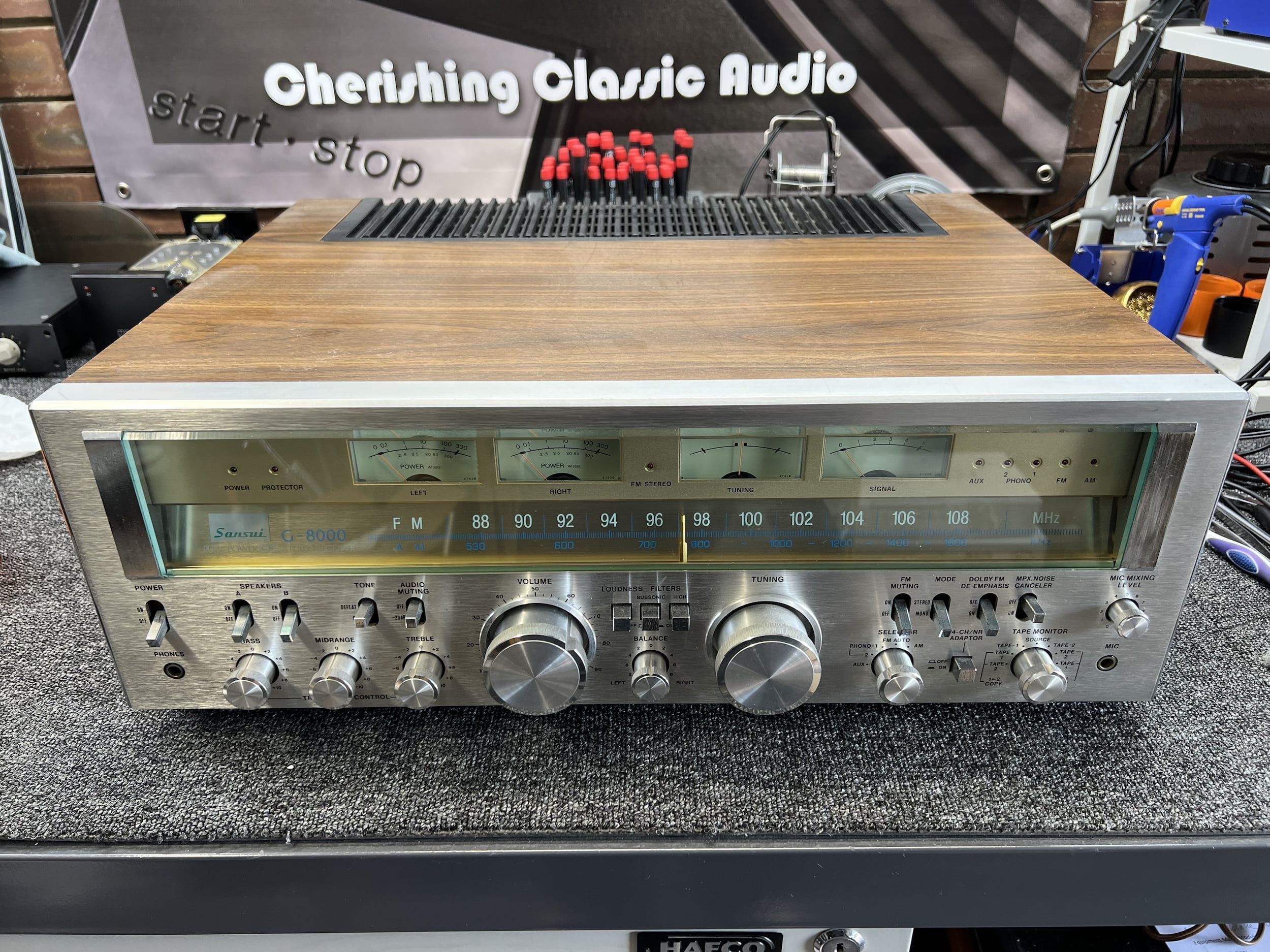
As always, you can watch an accompanying video about this story, courtesy of my YouTube channel:
Features
The Sansui G-8000 is a classic monster receiver, cut from the same cloth as the Pioneer SX-1250, even larger Sansui G-9000, Marantz 2330, Yamaha CR-2020 (I also have one of these and yes, it will be up for sale) etc.
Beastly receivers like this one came from an era when bigger was better, bigger was badder, badder was better, when men were men, smoked cigarettes (mostly unfiltered), and when everyone had a moustache. Well, men did anyway.
These ‘monster receivers’ as they are known, cram everything into one large box, which is much better than cramming into one small box as we see these days. These receivers are perfect for those wanting a nice ‘simple’ hi-fi system if you get what I mean, as long as large and simple go together for you and simple means lots of nice switches and knobs in one place.
Receivers are always compromised to some extent, any integrated solution in. Monster receivers like the Sansui G-8000 though are less compromised than you might imagine, packing in serious amplifiers, phono preamp, tuner etc that you would find in separate components from the time.
I wrote about this very Sansui G-8000 receiver when I first worked on her, so check that out for more info.
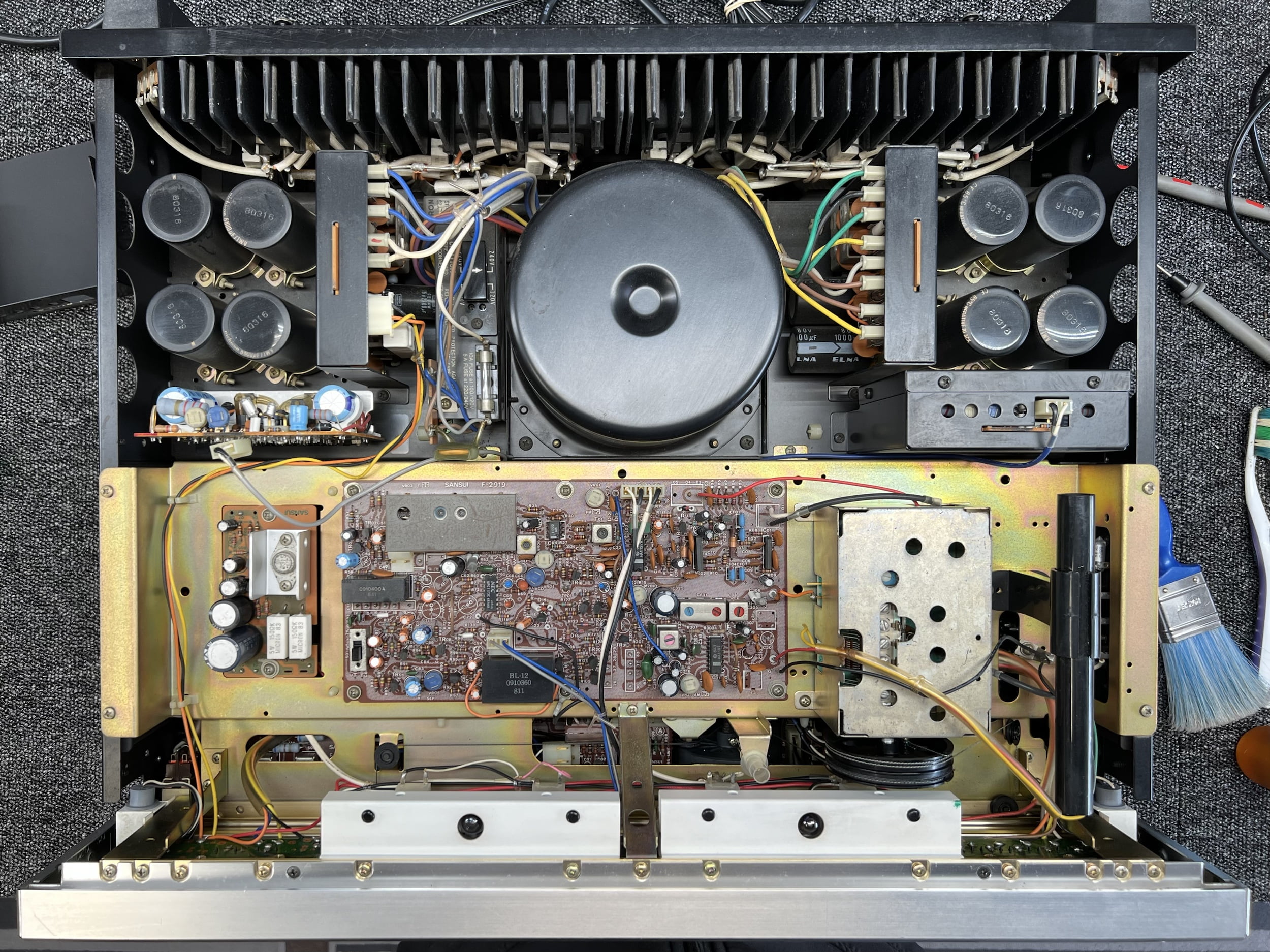
This beast has a dual-mono 120 Watt amplifier configuration, high-quality discrete phono stage, eight filter capacitors spread over the two amplifier power supplies, a great preamplifier, AM/FM stereo tuner built-in and more.
Everything has its own power supply for maximum sound quality, even the tuner. Each circuit block is housed in steel shielding boxes for reduced noise and the controls are silky smooth as one would expect of a beast like this. One ‘twiddle’ of the tuning knob and she runs from one end of the dial to the other. That’s after I carefully lubricated the tuning mechanisms of course.
As you would expect, she sounds amazing and having everything in one box really simplifies things. You just need space for one B-I-G box.
Sansui G-8000 Specifications
Courtesy HiFi Engine
Tuning range: FM, MW
Power output: 120 watts per channel into 8Ω (stereo)
Frequency response: 5Hz to 50kHz
Total harmonic distortion: 0.03%
Damping factor: 60
Input sensitivity: 6mV (mic), 2.5mV (MM), 150mV (DIN), 150mV (line)
Signal-to-noise ratio: 78dB (MM), 95dB (line)
Channel separation: 60dB (MM), 70dB (line)
Output: 150mV (line), 43mV (DIN), 1V (Pre out)
Speaker load impedance: 4Ω to 8Ω
Semiconductors: 104 x transistors, 70 x diodes, 11 x FET, 7 x IC, 10 x LED
Dimensions: 560 x 201 x 475mm
Weight: 24.6kg
Finish: simulated walnut grain
Problems
This time the old girl was silent out of one channel and clearly in need of some TLC. This is not unexpected for any equipment of this age and I’d already explained to her owner that she really needed TLC seven years ago. Everything needed cleaning, lubrication, and adjustment and the driver boards needed maintenance, above all else.
This job is not a full overhaul or restoration, but you can consider it a minor overhaul, given the range of work done here. Her next owner can have even more done if they so choose, but my goal was to get this lovely receiver running perfectly again, so let’s go!
Repair & Service
As always, I started with functional testing, some measurements and an inspection, so that I knew what I was dealing with. Straight away I knew that work would be needed on the driver boards, so that’s where I started.
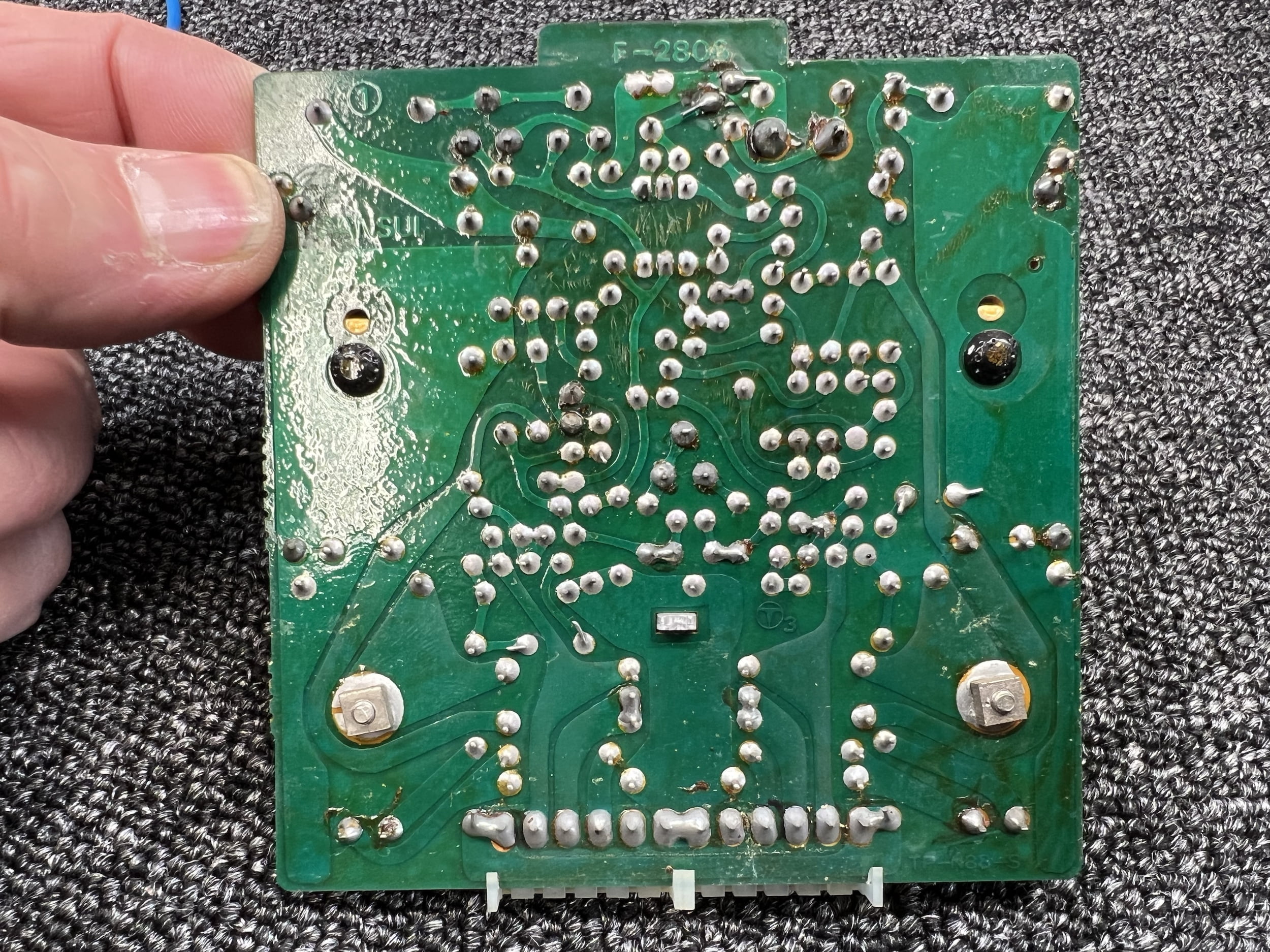
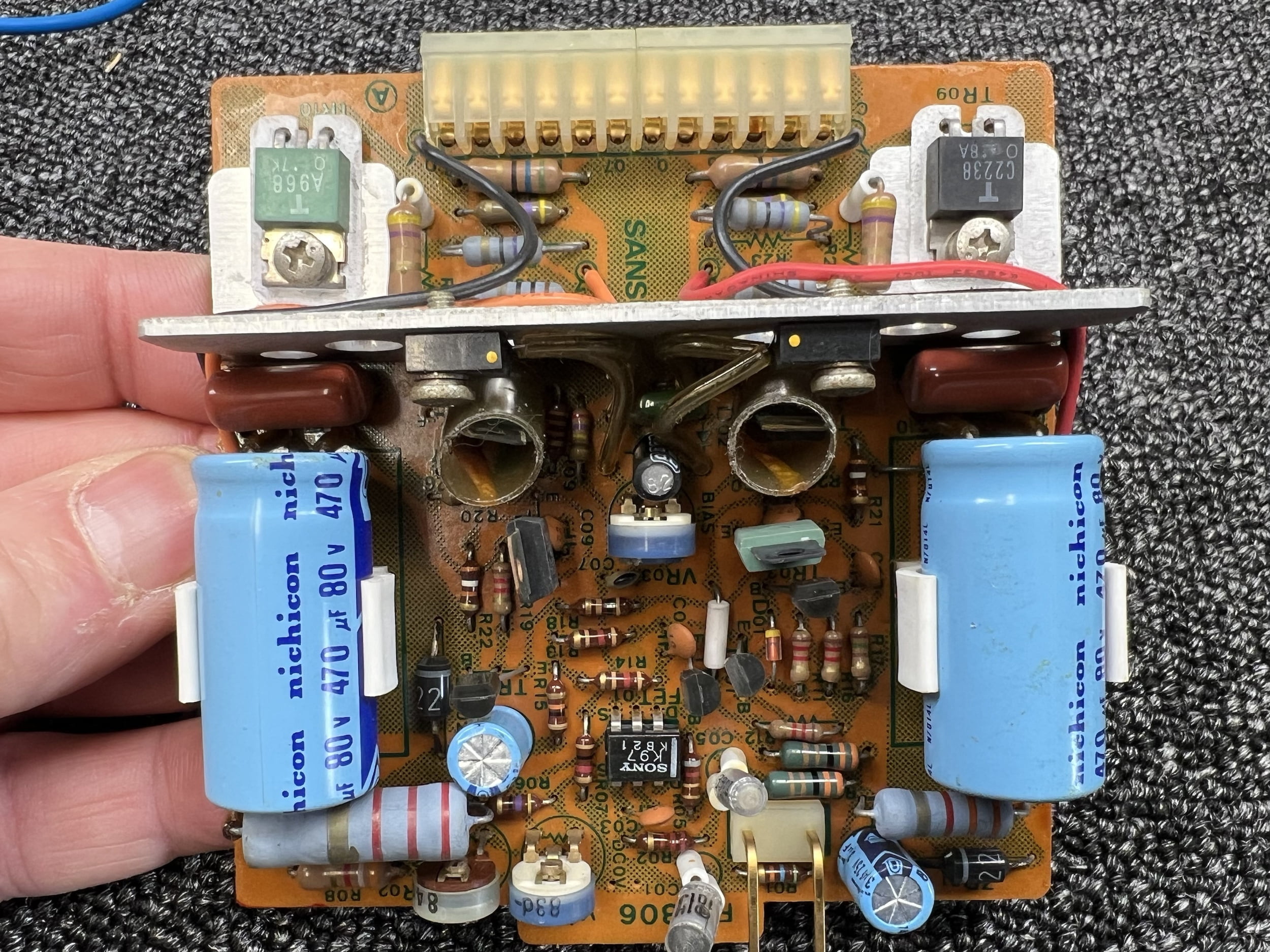
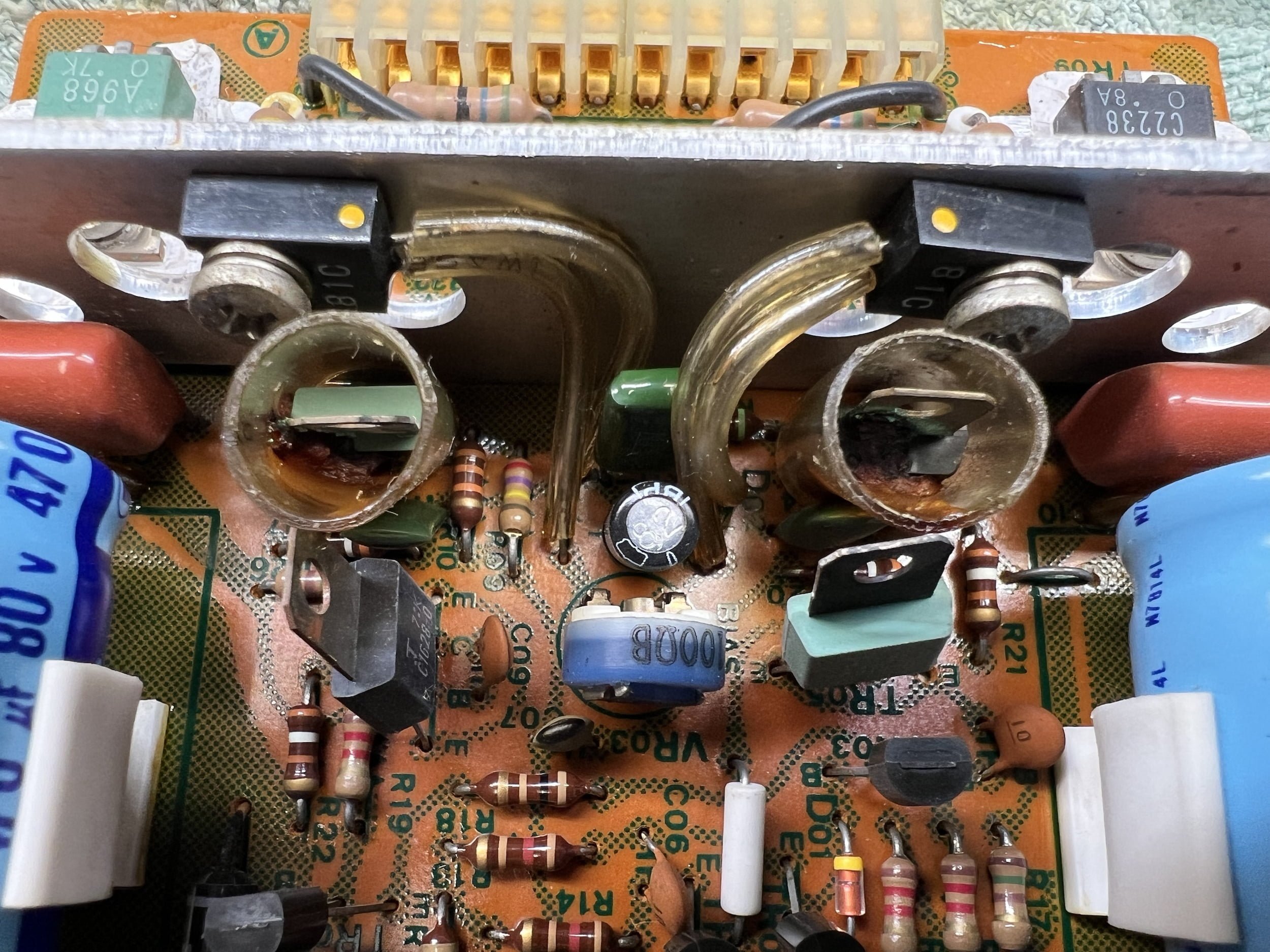
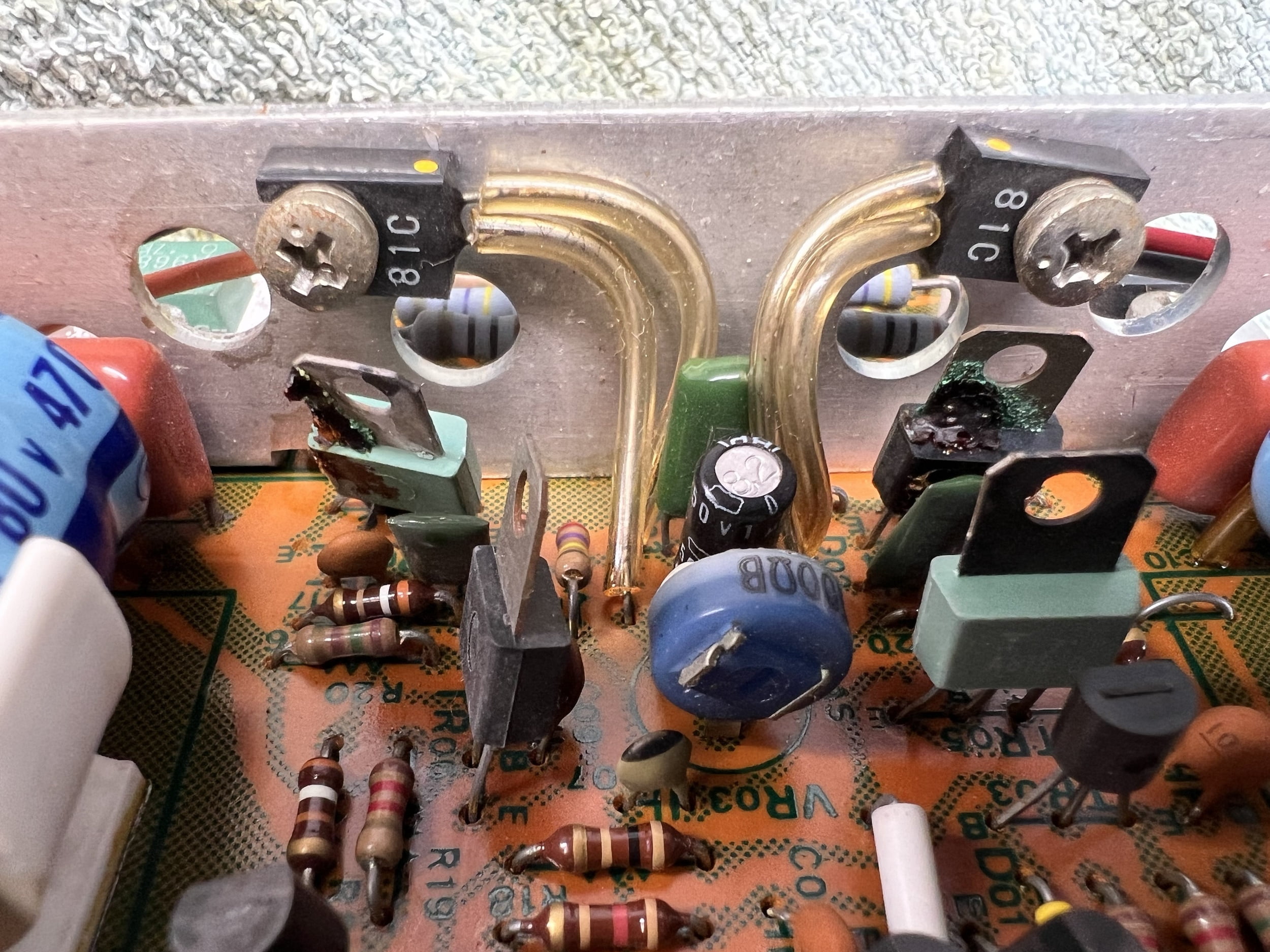
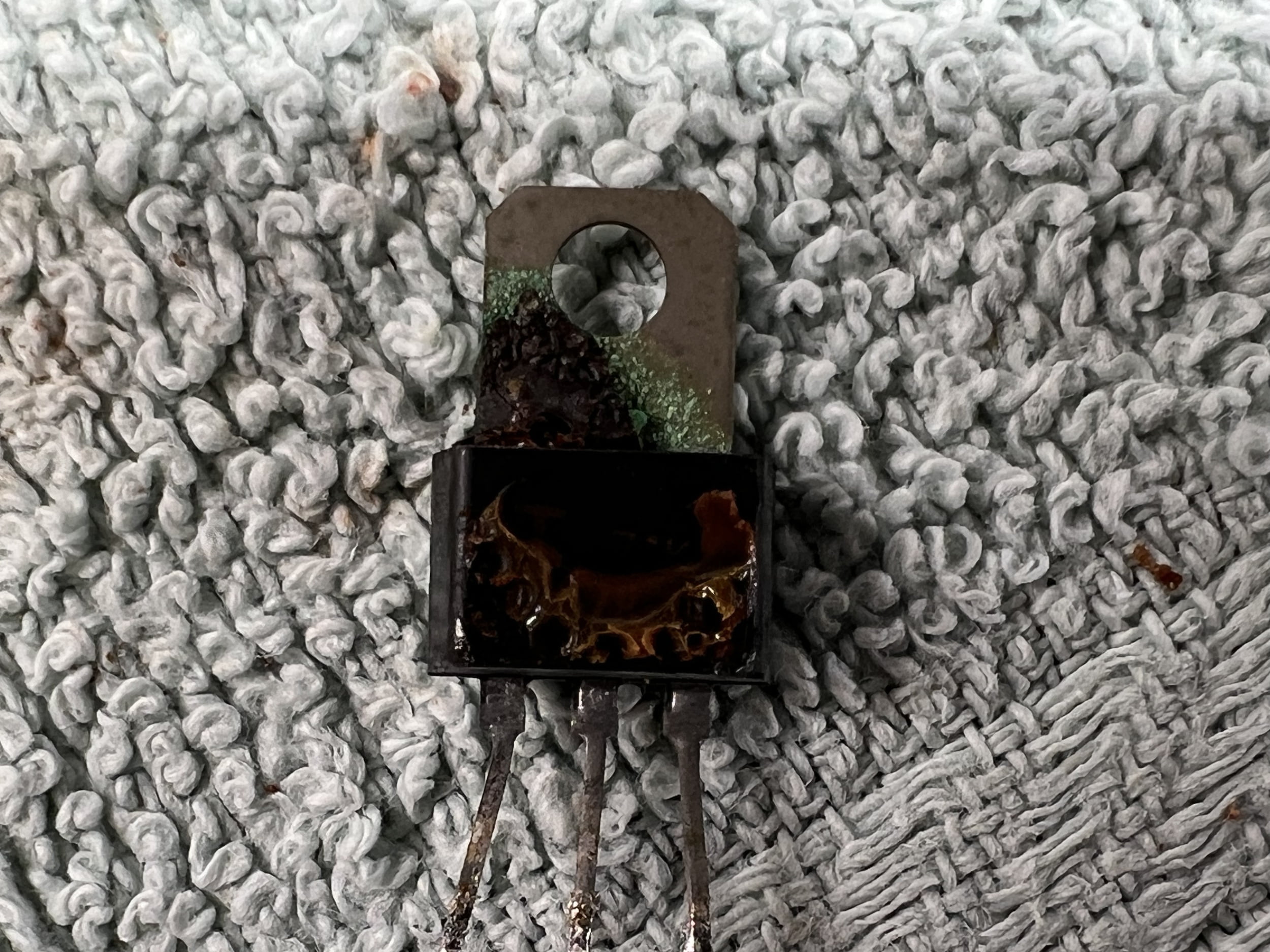
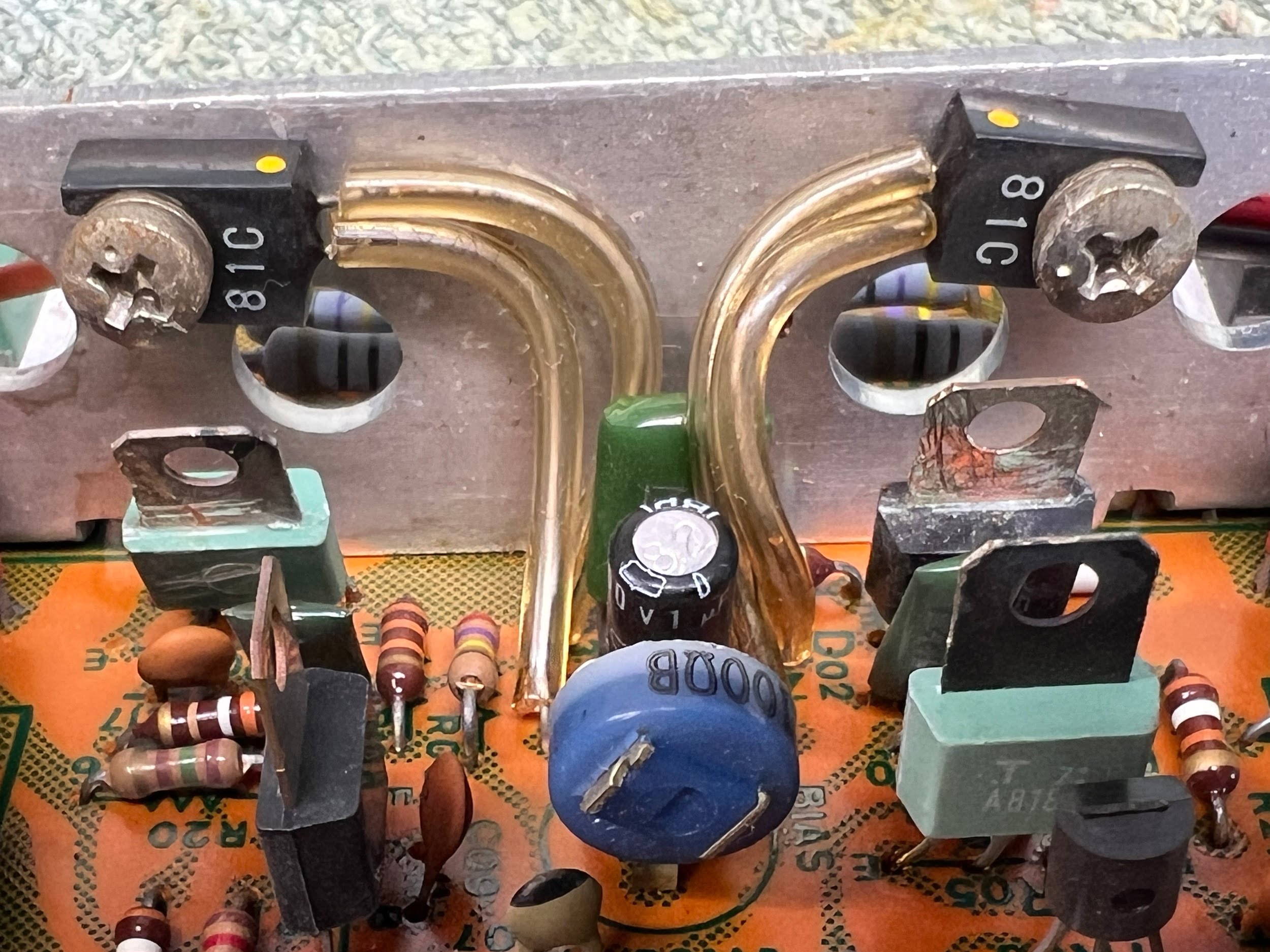
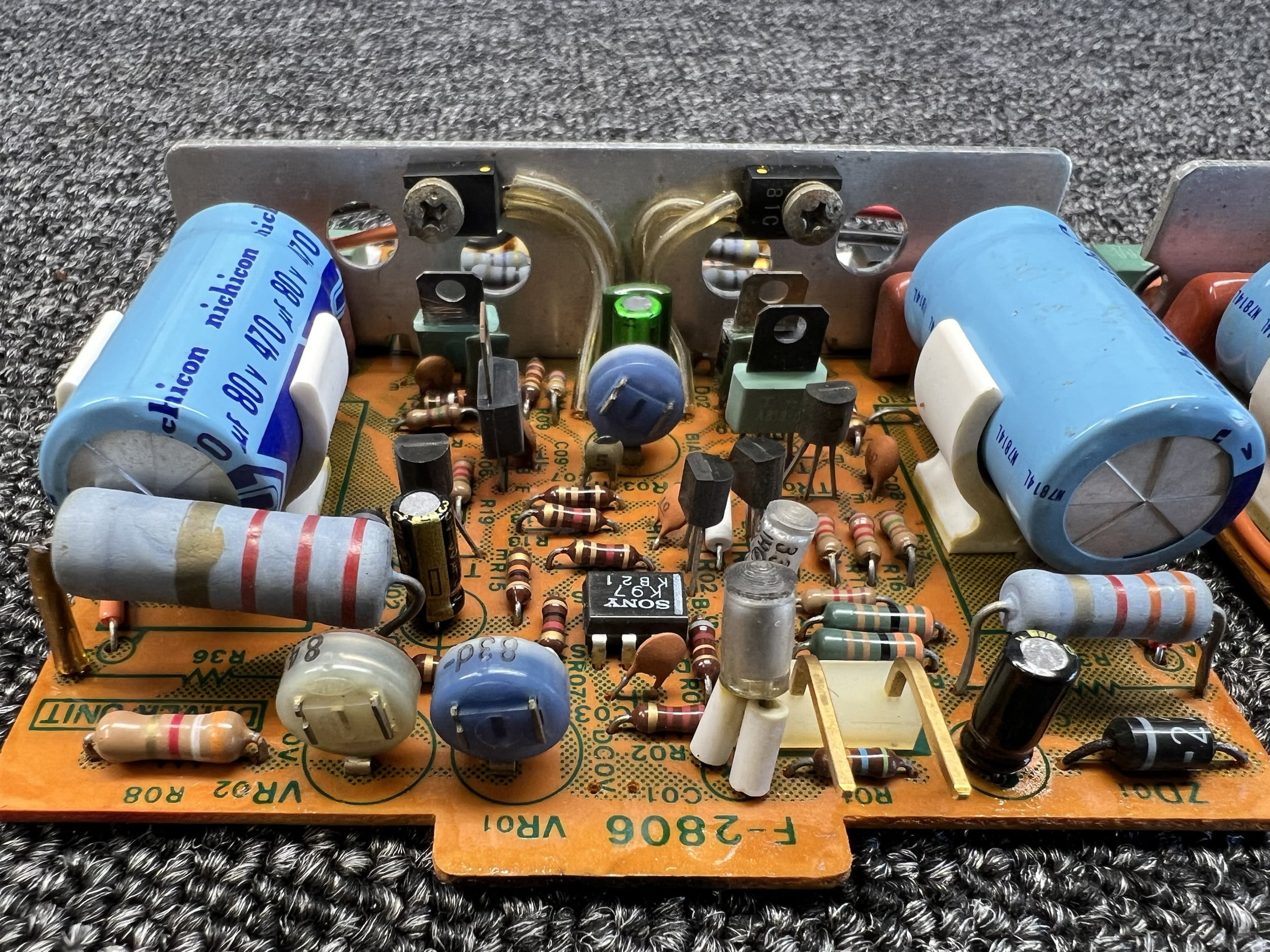
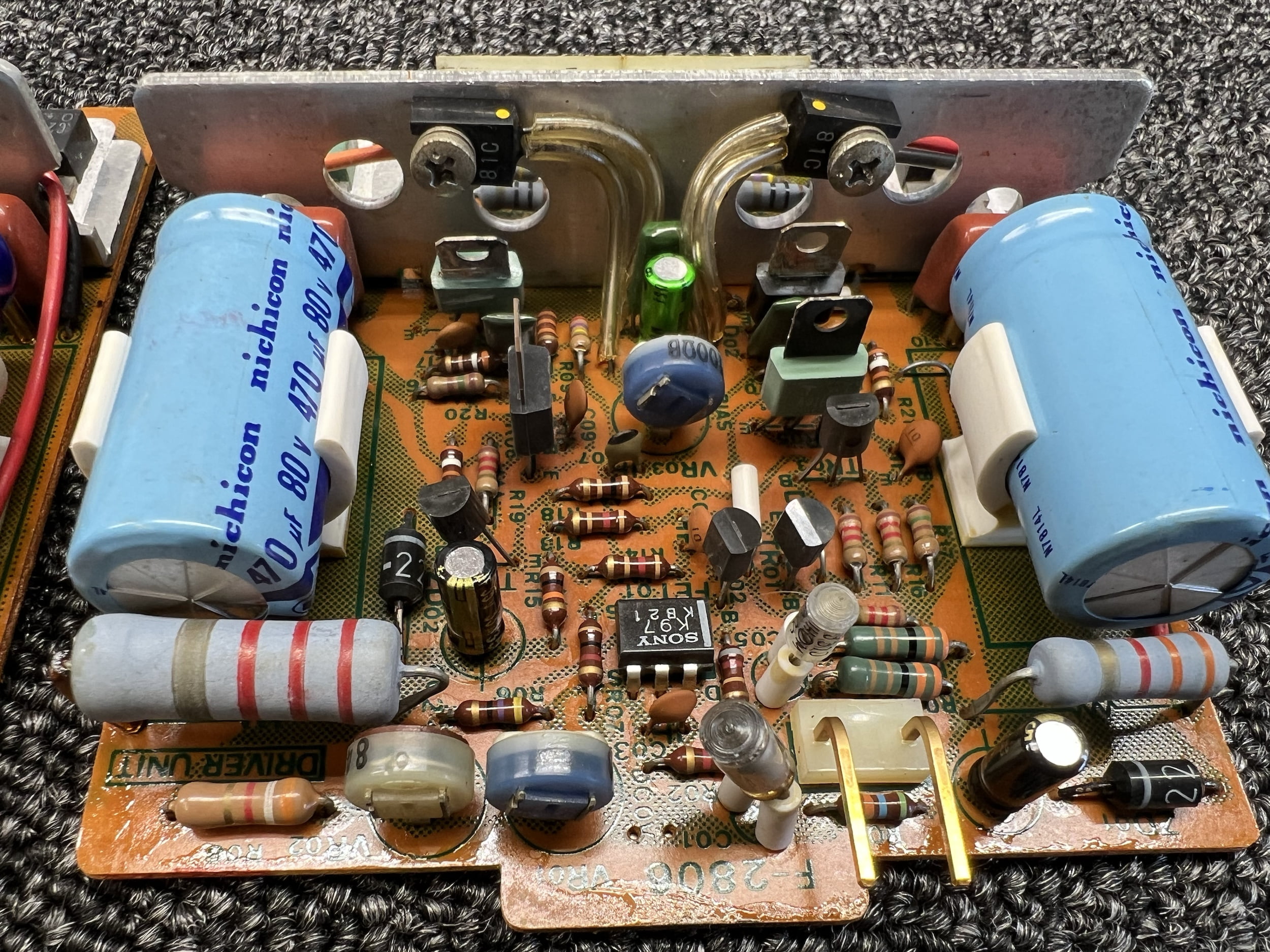
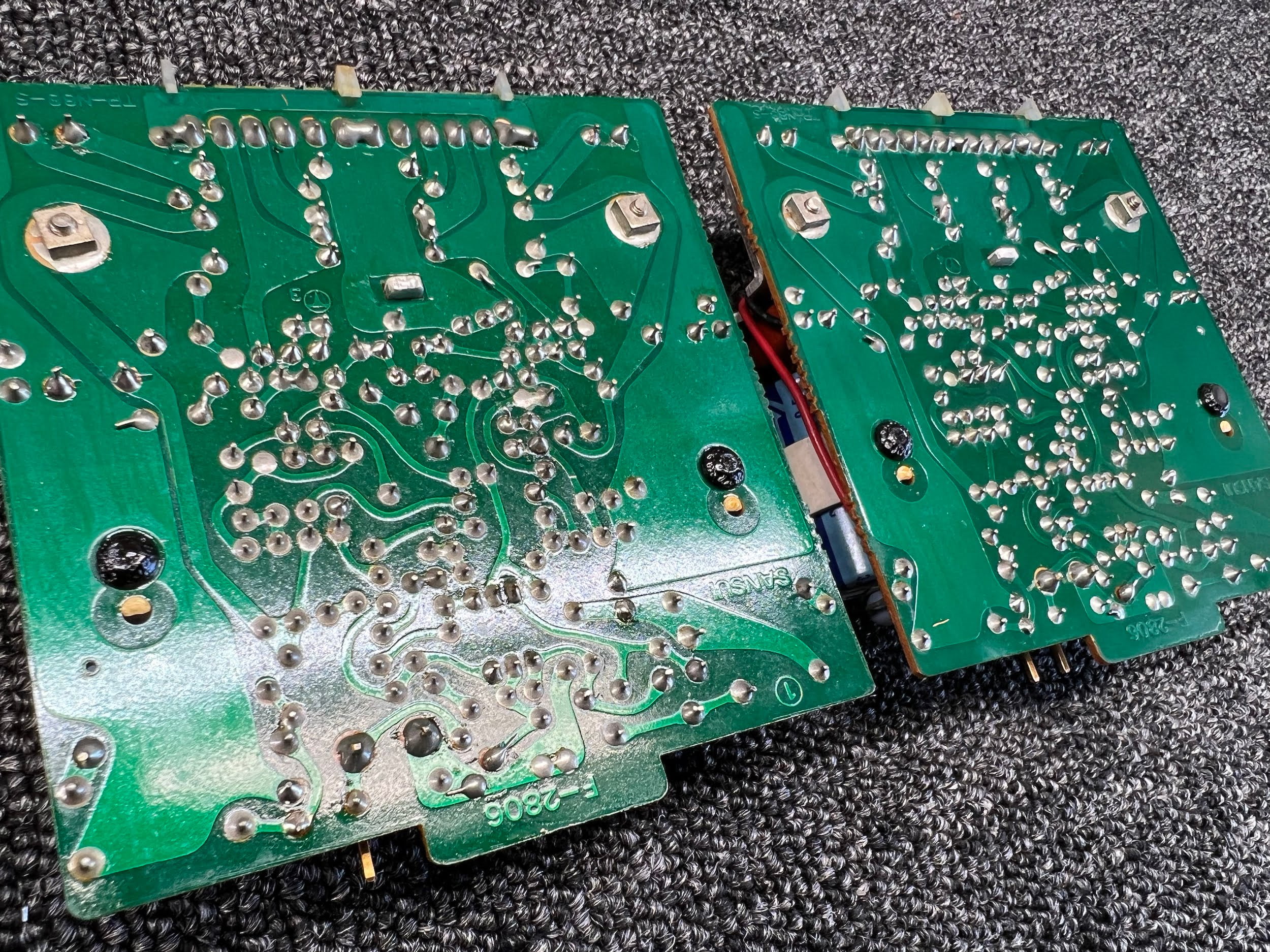
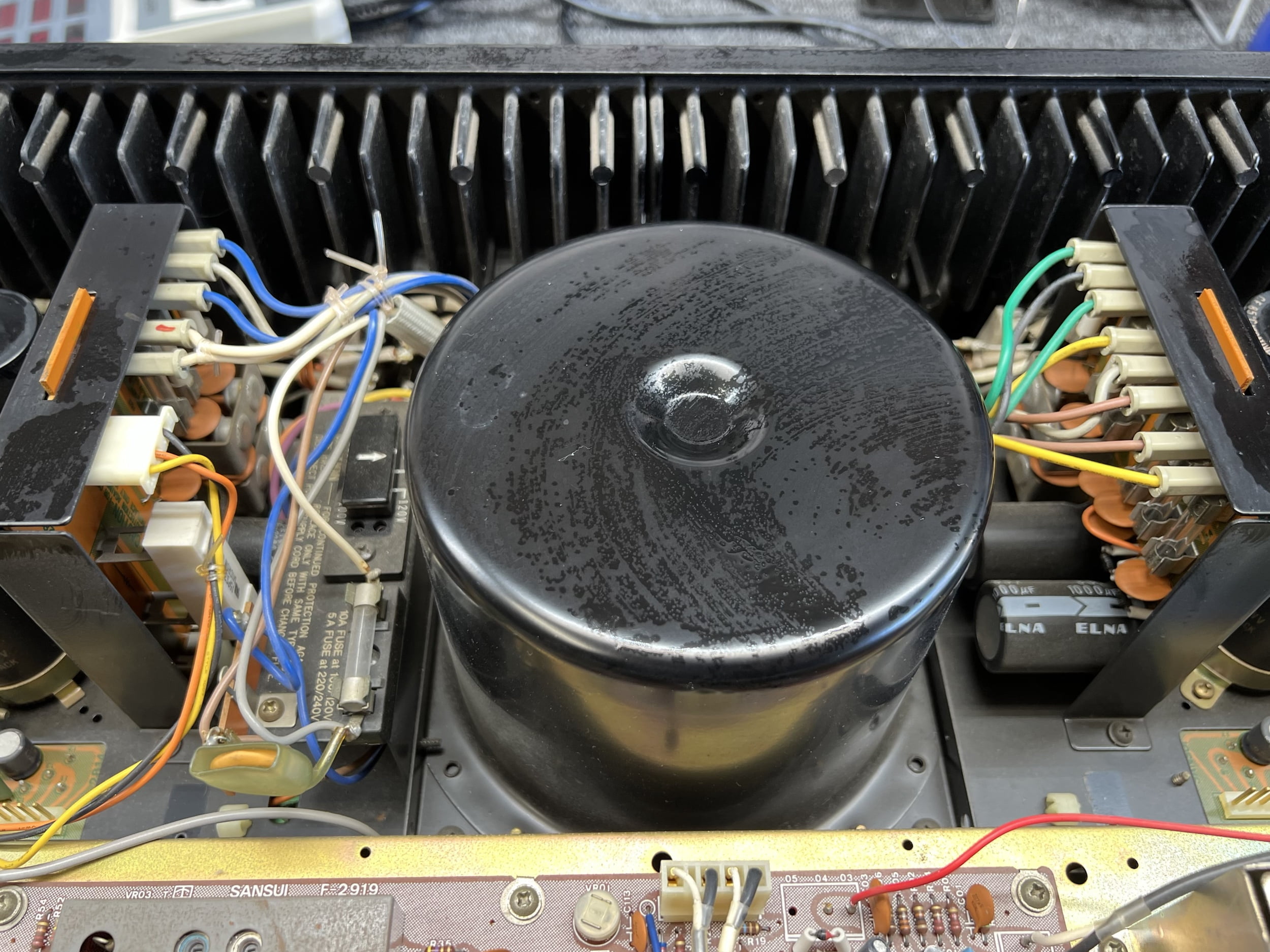
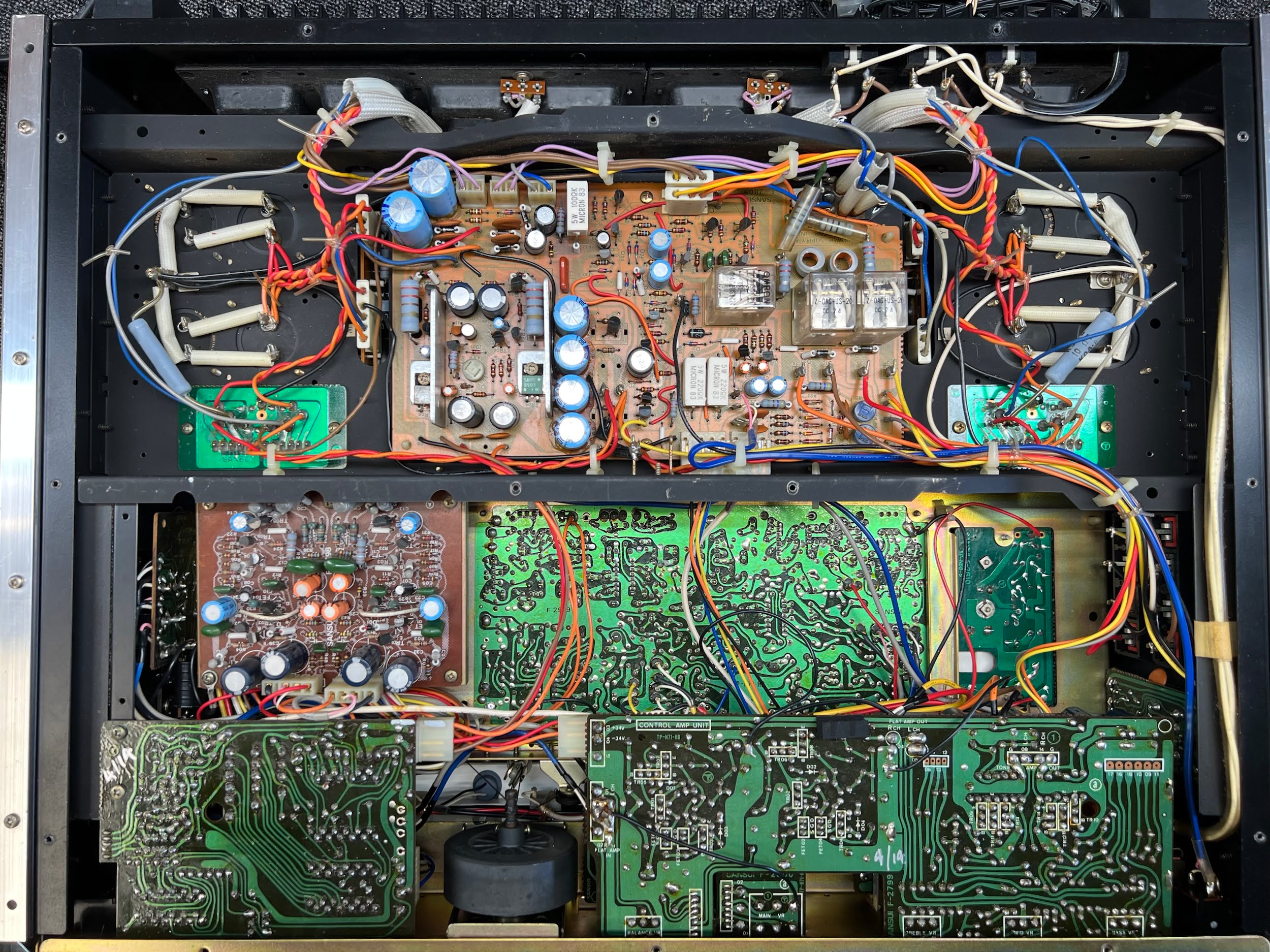
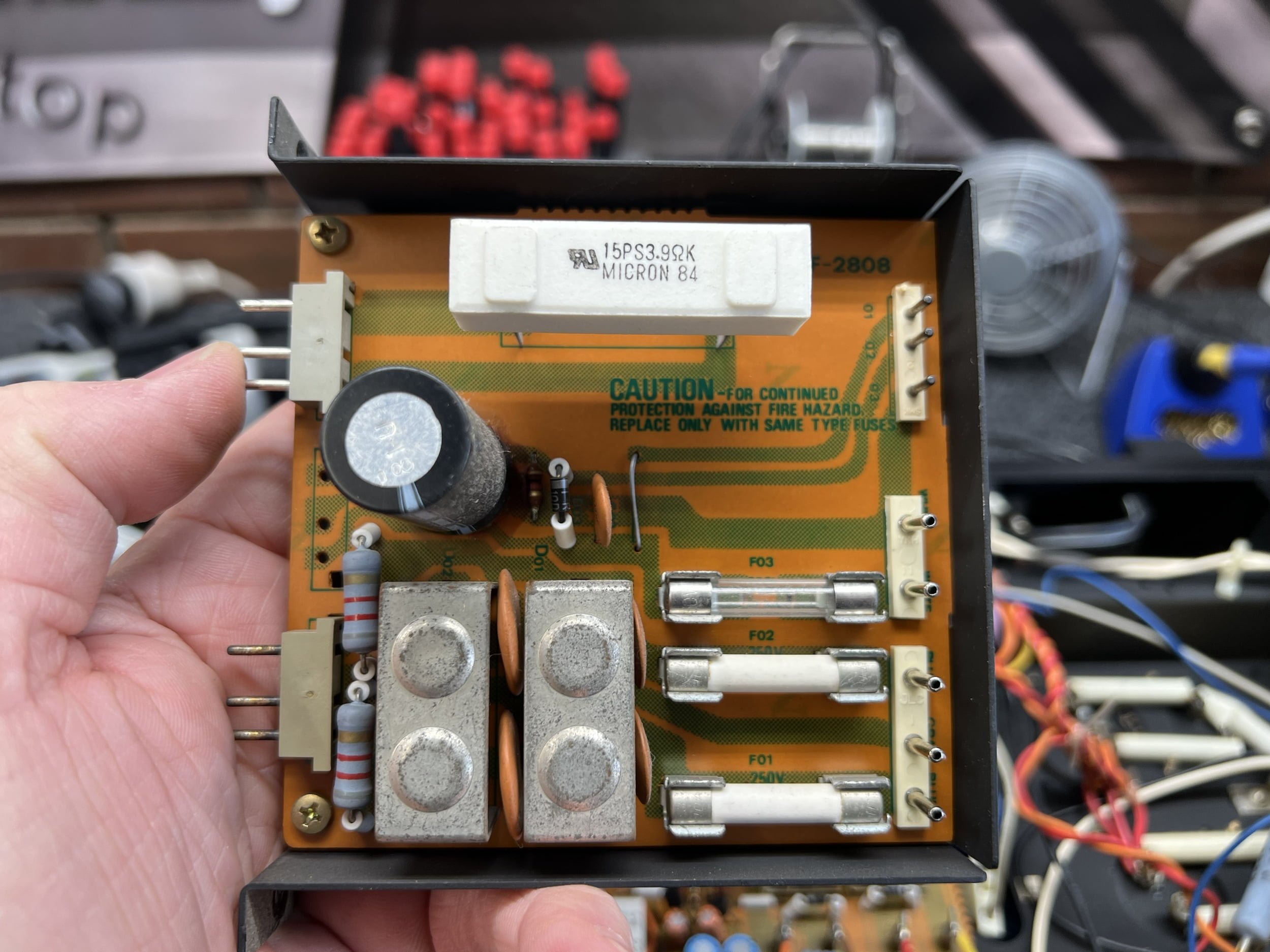
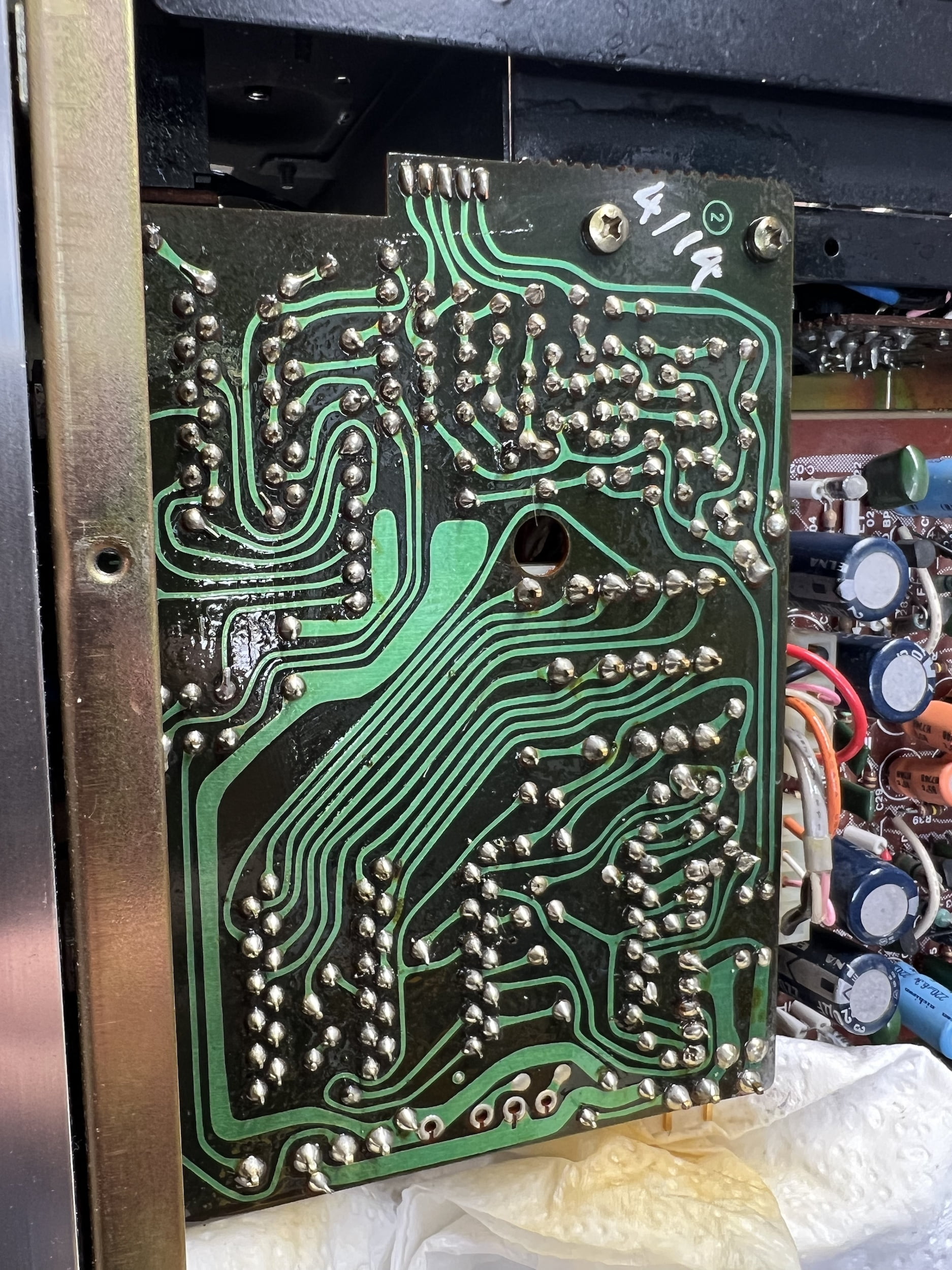
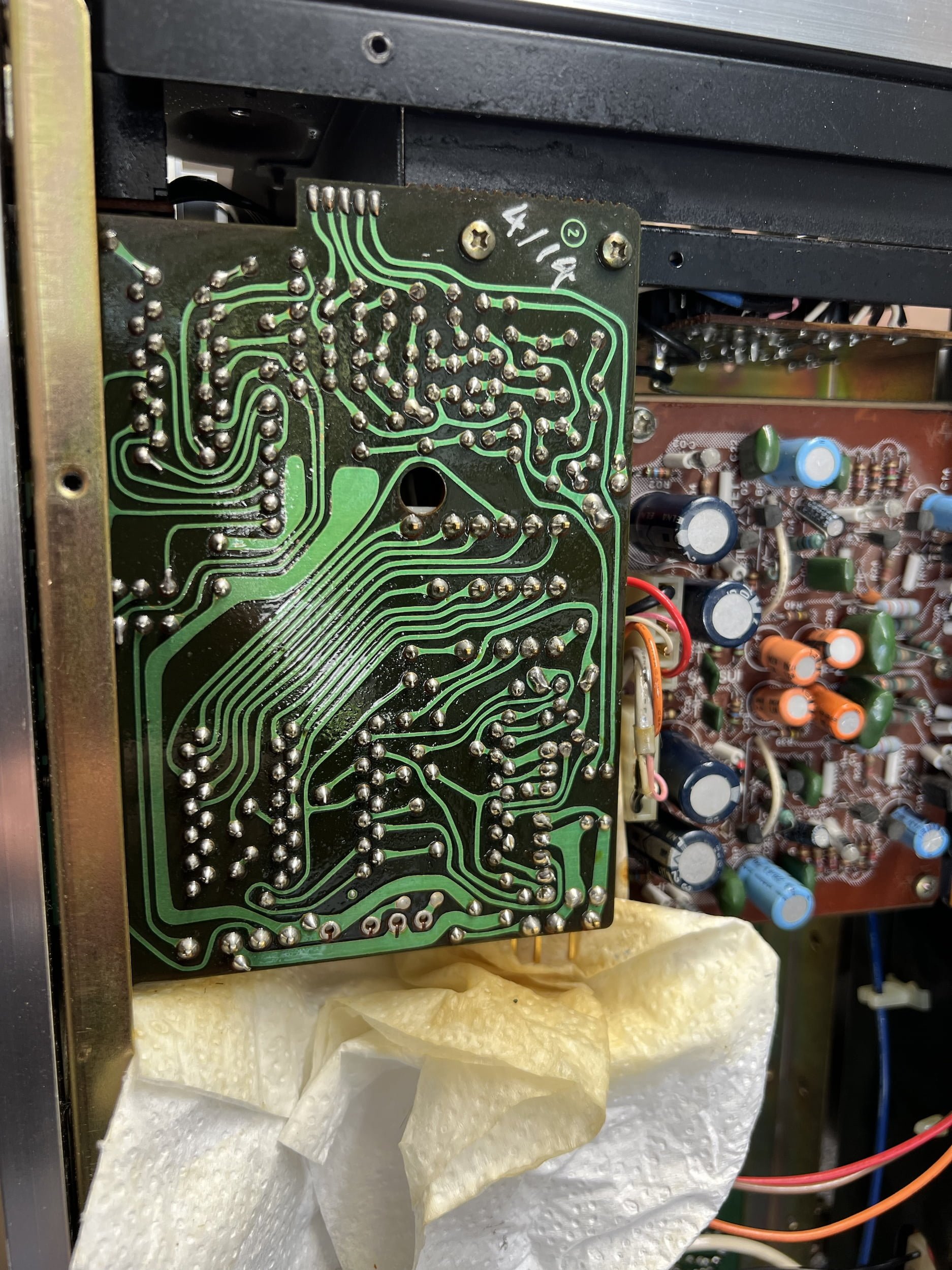
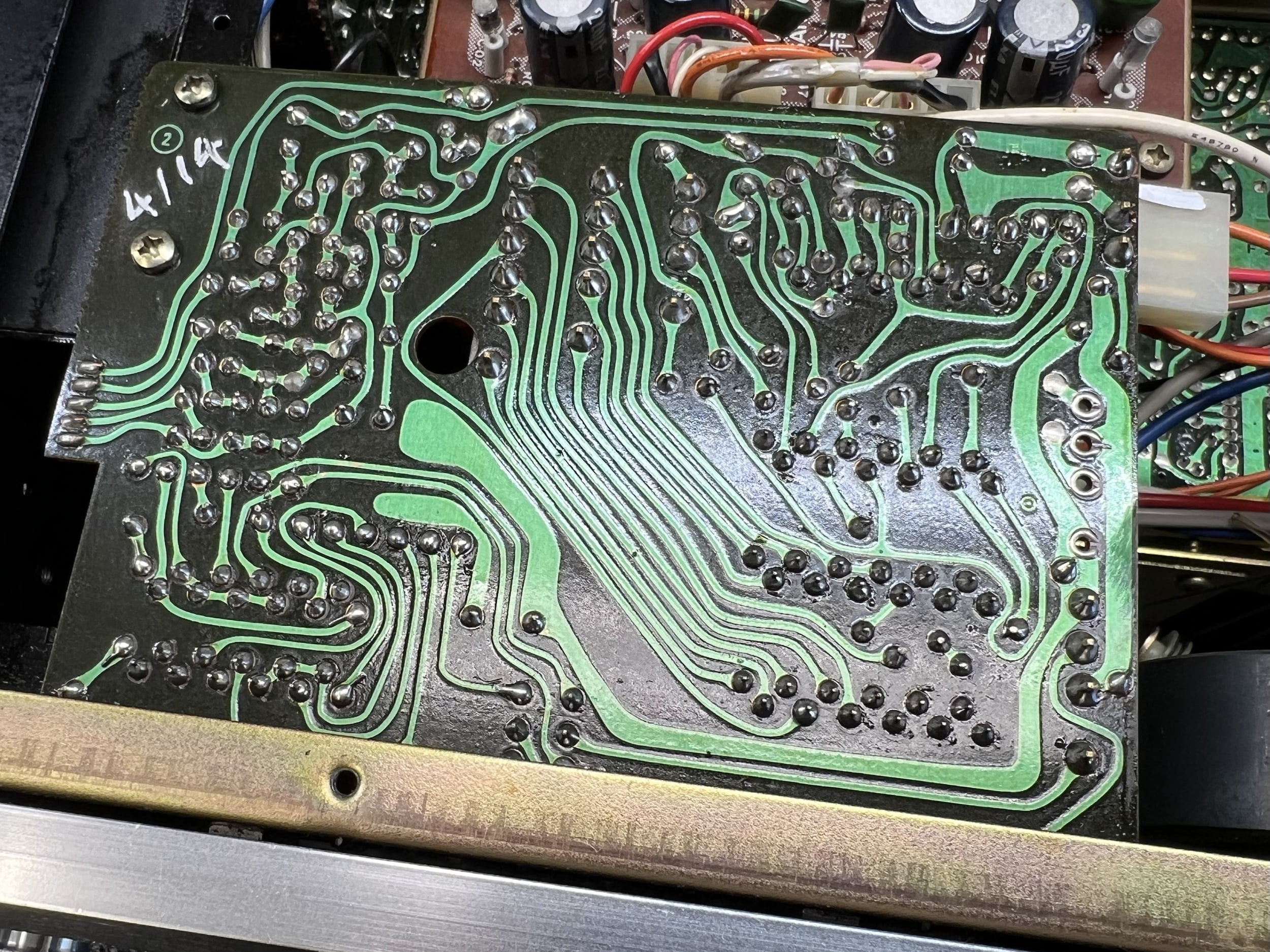
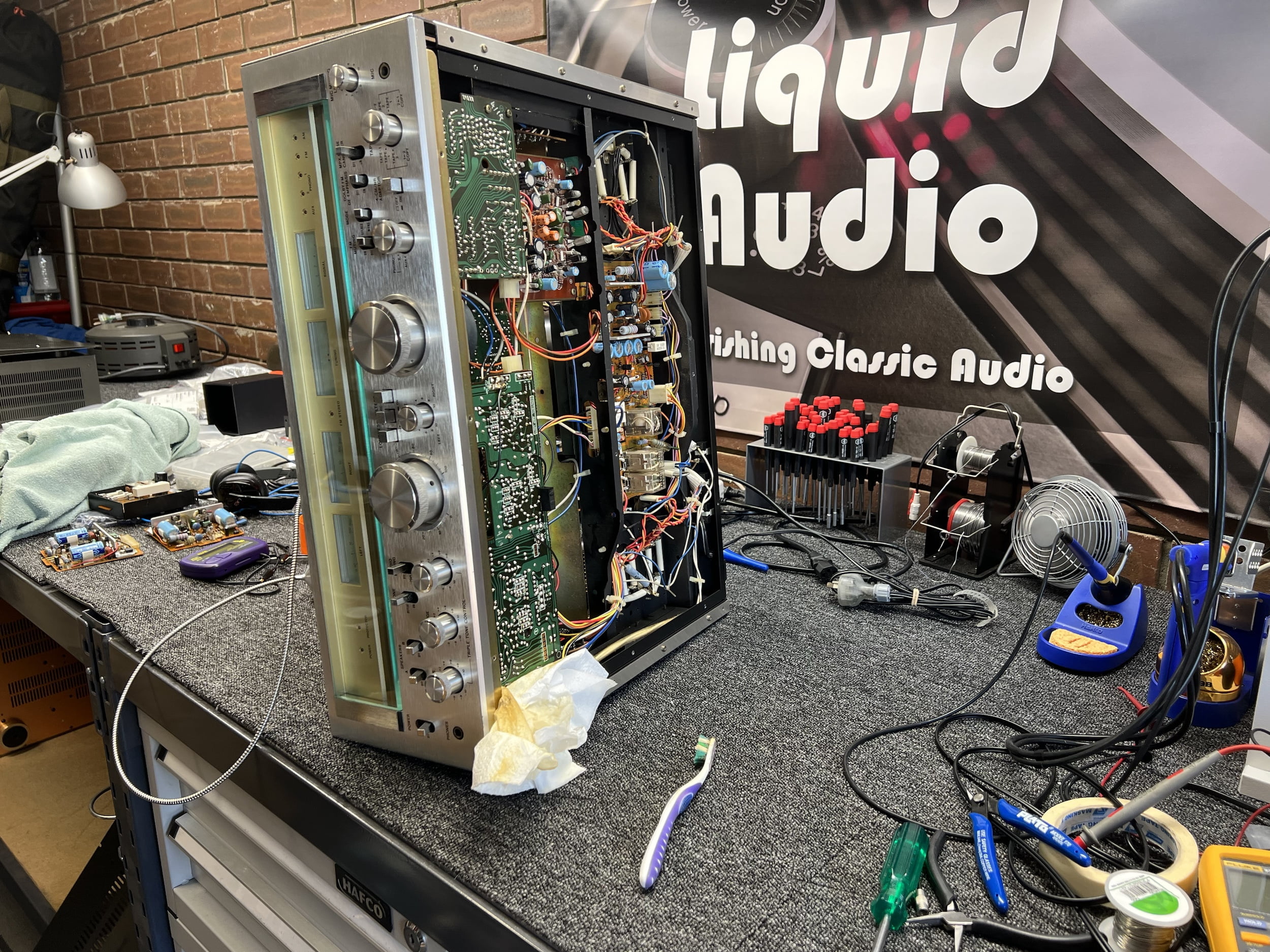
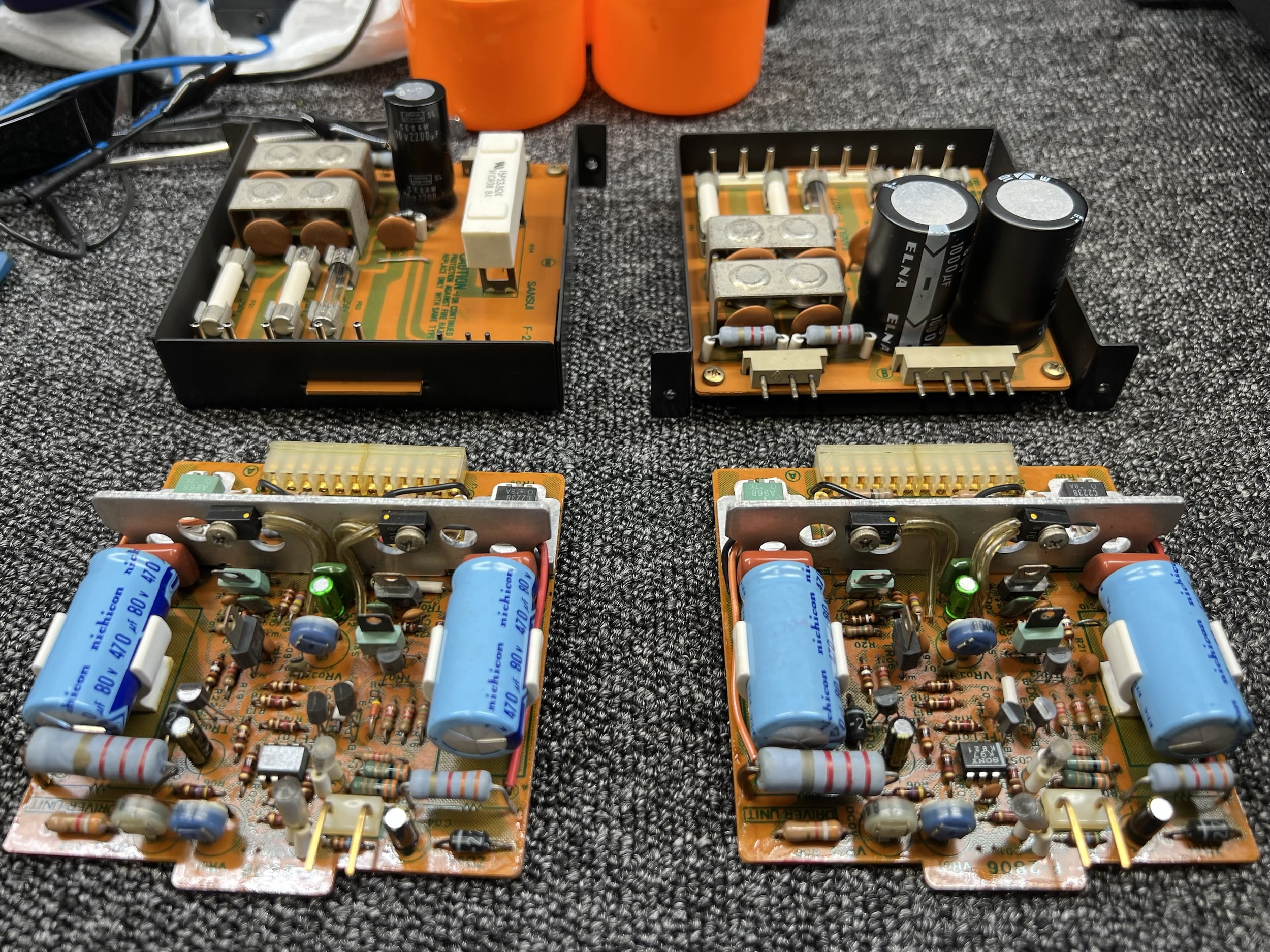
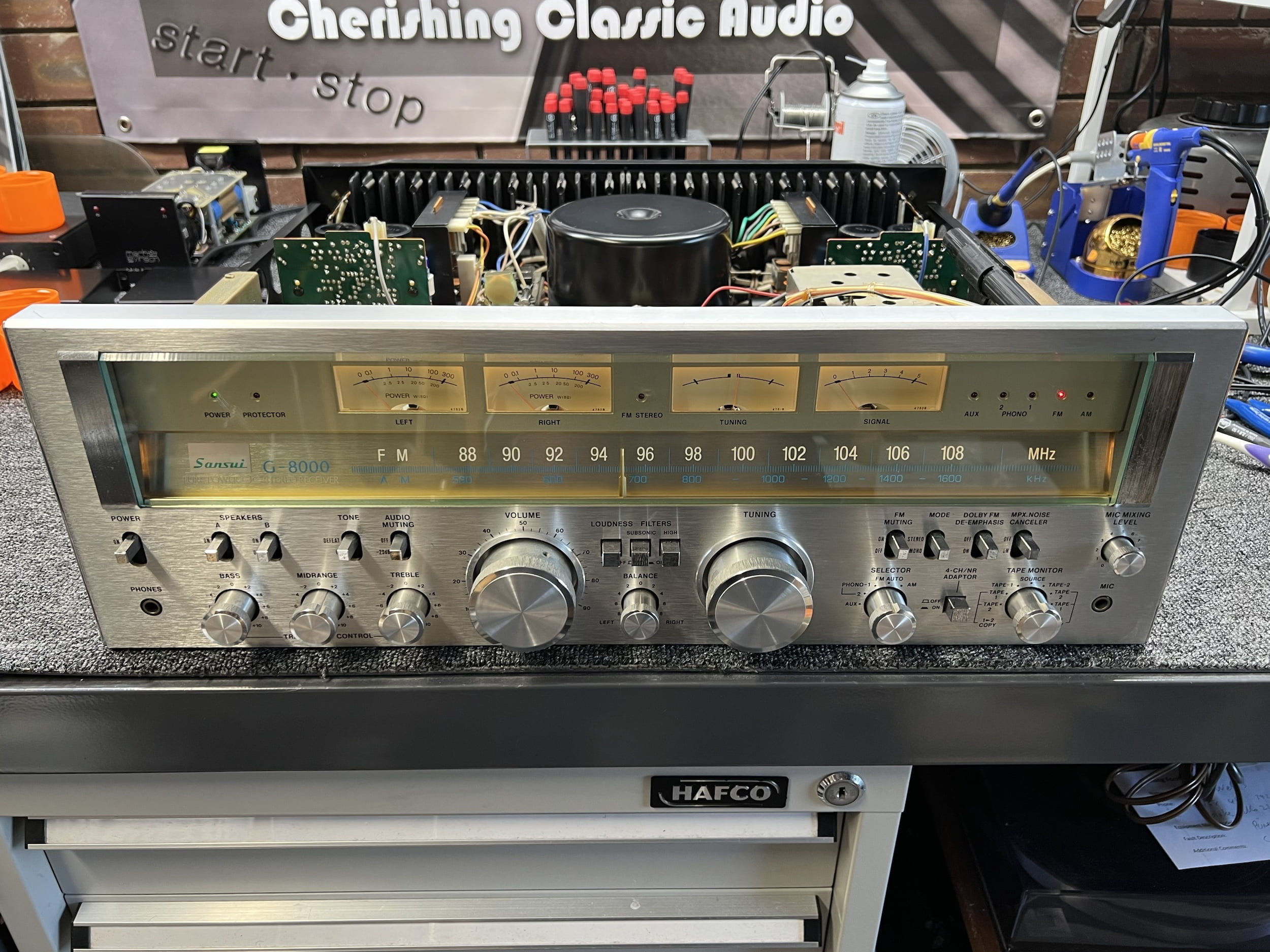
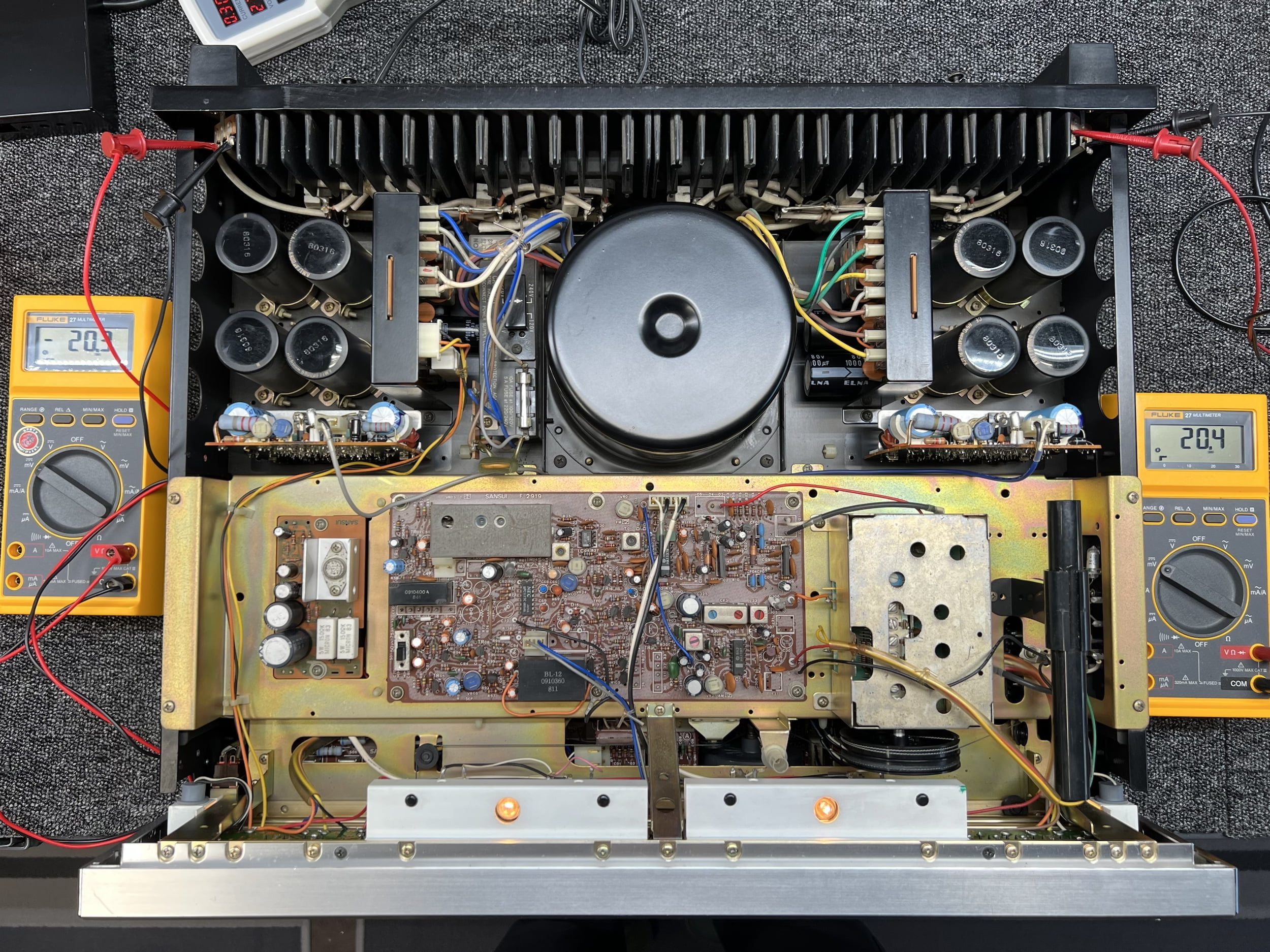
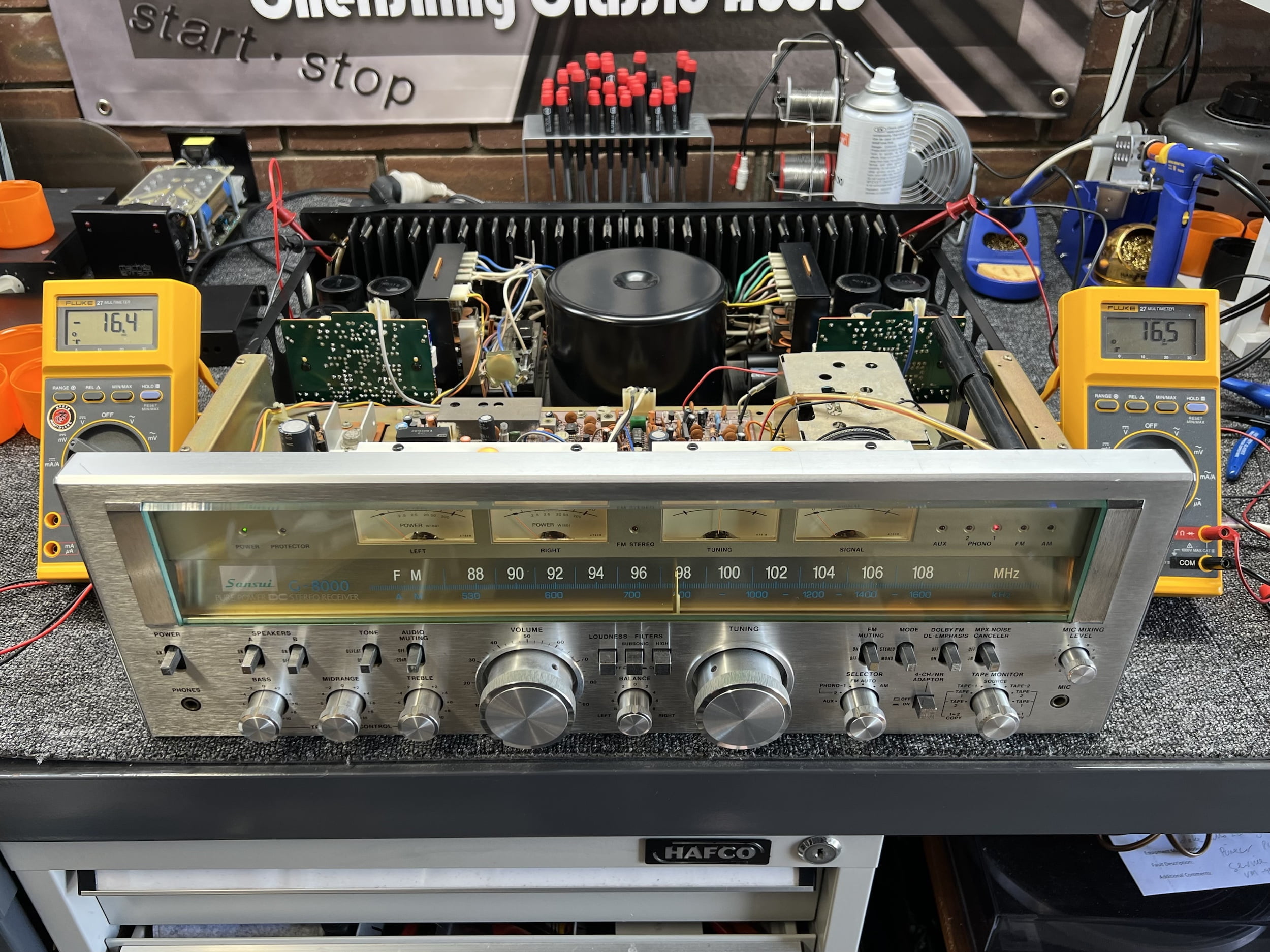
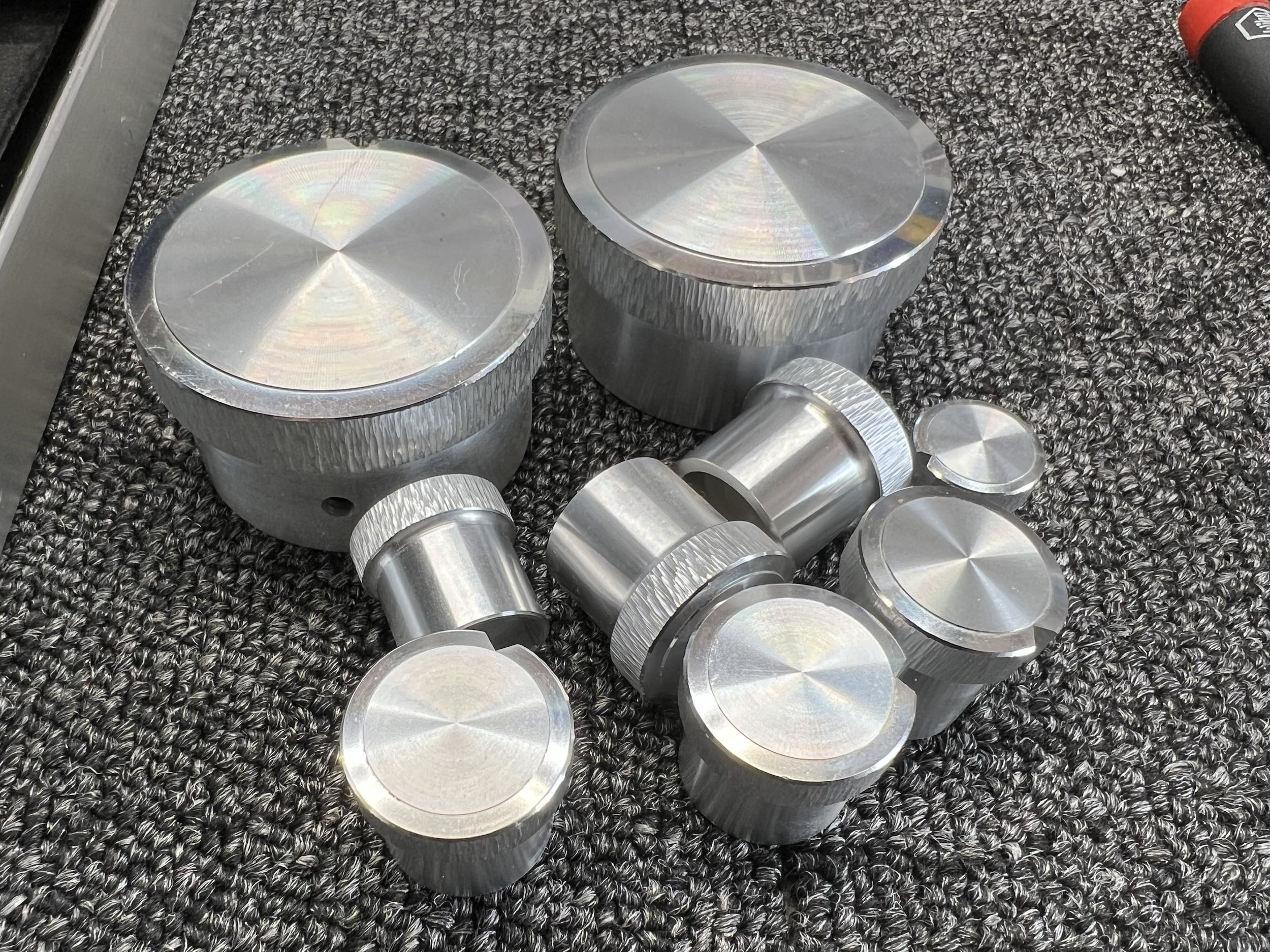
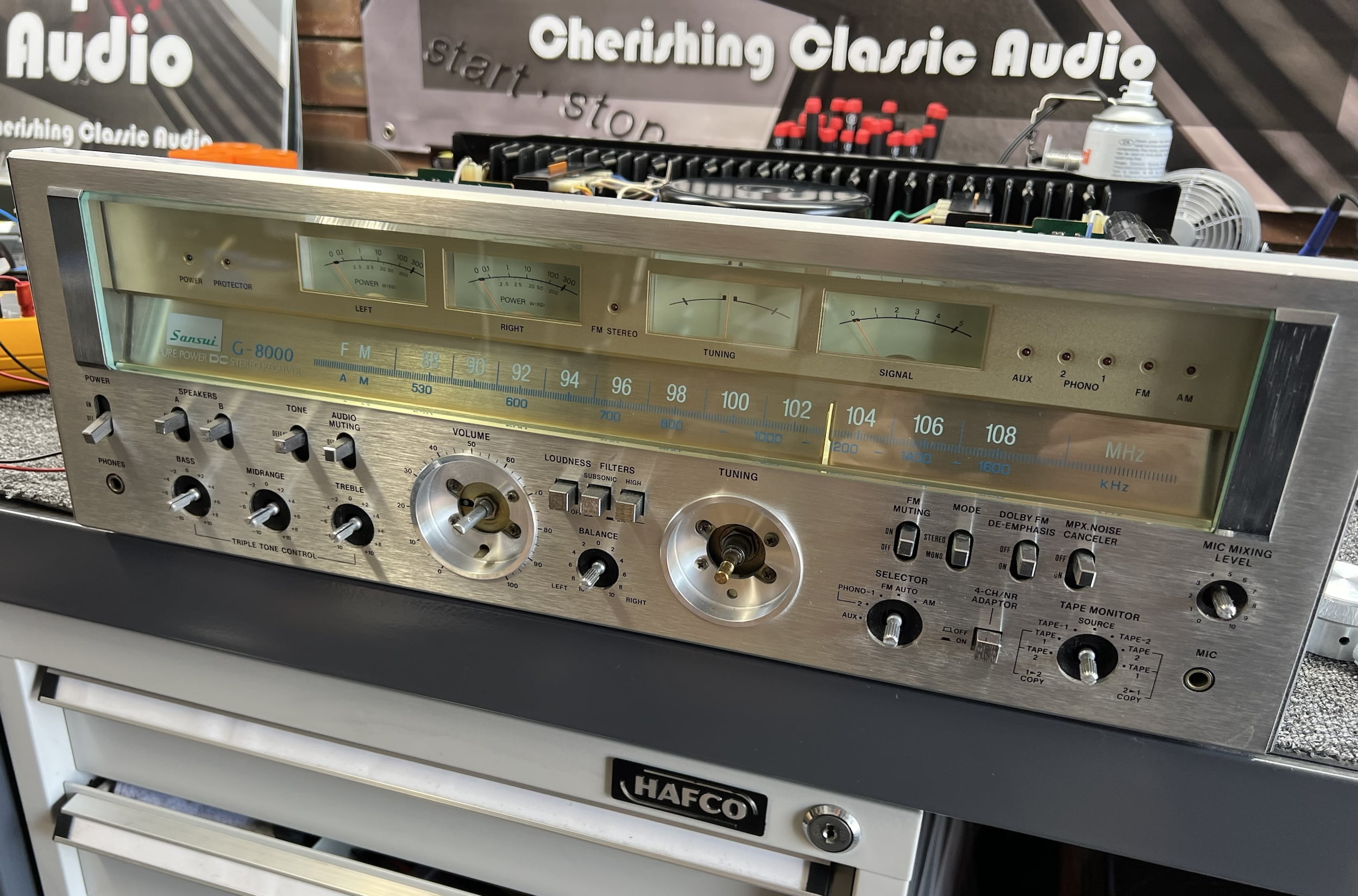
Results
With the critical maintenance work complete, the Sansui G-8000 runs perfectly again and sounds amazing, as you’d expect of such a piece. All the controls operate smoothly, and both channels sound fantastic which is helpful! Bias current is very stable and DC symmetry is spot on and stable over time, all great signs of amplifier health.
I must point out and as you’ll see from the work above, I spent a good few hours on this job. That’s absolutely to be expected for a piece of this age though and with this little prior service history. This would have been a very affordable repair, had I billed it out, and I strongly encourage owners of equipment like this Sansui G-8000 to have minor repairs and maintenance like this done vs getting rid of a piece like this.
I’d love to have done this work for my customer and have him keep the G-8000, but I also understand that sometimes we lose the love we had for a piece of gear, and maybe that happened here. There are also other circumstances and life events that crop up and these may have played a part in his decision to get rid of the old girl.
Anyway, Daryl, if you’re reading this, I hope you are still happy and pleased with the results I achieved here! Thank you for passing her on to me rather than throwing her away. I really appreciate it and thoroughly enjoyed working on her, as I do all classic Sansui gear.
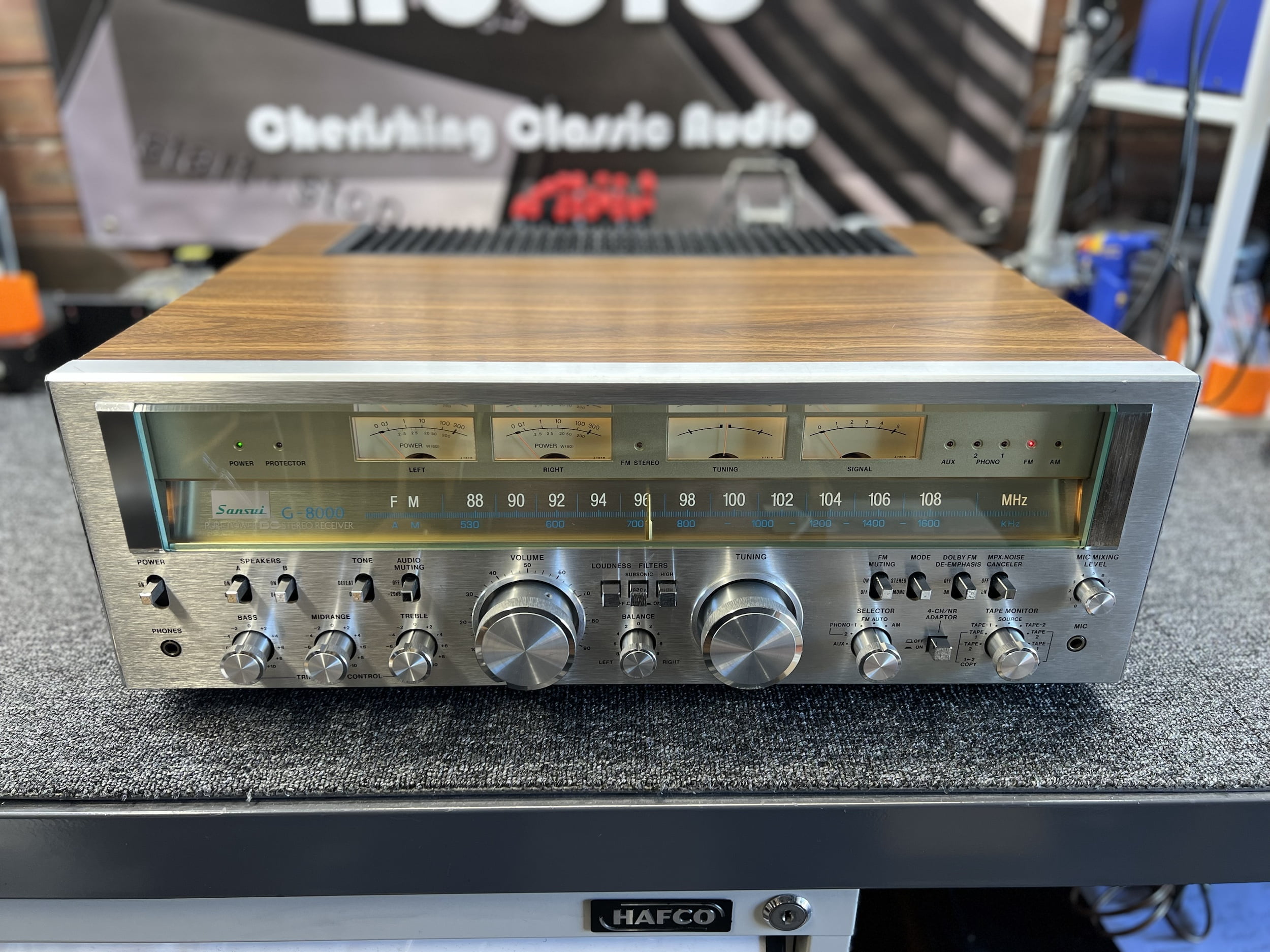
Sonically, this receiver is big, just like she looks. The headphone amplifier sounds great and the phono preamplifier is quiet and hum-free. I especially like the tuner, Sansui always knew how to make excellent tuners and this one is no exception. The built-in ferrite rod antenna means AM reception is clear and strong and a standard FM ribbon dipole will see excellent FM reception, too.
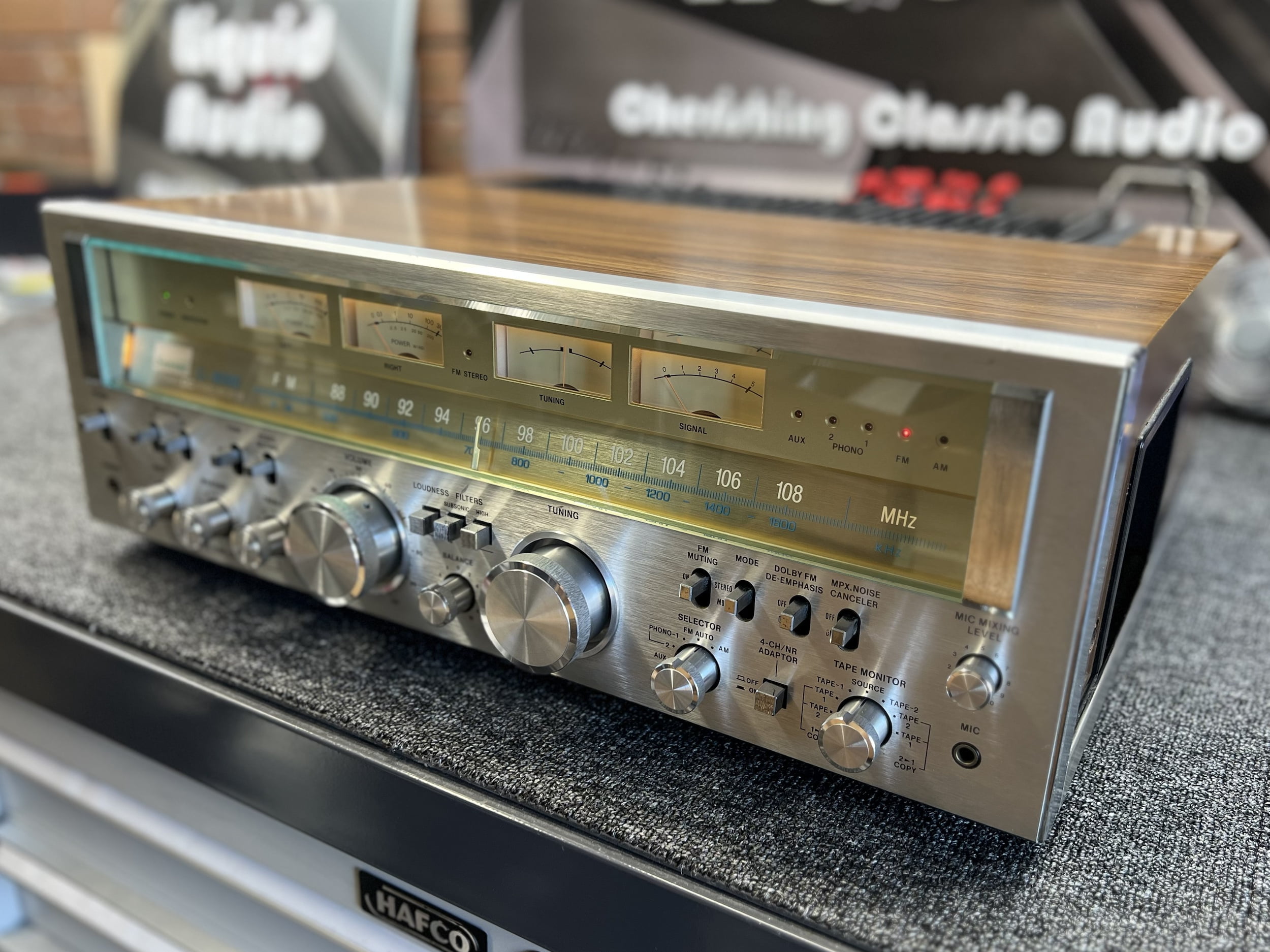
In terms of replacement value and rarity, let’s just say that nothing like this will ever be made again. Surely, to build this receiver now, in the way this Sansui G-8000 is built, it would have to sell for $10,000 AUD. Maybe they could make it for less, but gear like this really was of its time and quite unique. Plus, it doesn’t have Bluetooth… 😉
This means that people like us are left to enjoy wonderful old pieces like this and marvel at their build, features and performance almost a miracle, from a bygone era of hi-fi.

For Sale
As I mentioned, I now briefly own this wonderful Sansui G-8000 and, whilst I’d love to keep her, I can’t. I have way too much gear like this and I need to move this unit on. She deserves a new home where she will be used rather than stored as she would be here.
How often do you think one of these comes up for sale, in this condition? Head over to the Liquid Audio Store and click on the ‘Receivers’ link, which will take you to the listing. Don’t hesitate to let me know if you have any questions.
UPDATE: Sold!
I knew it wouldn’t take long for such a wonderful piece, freshly serviced and in such great condition to find a new home. Here’s what the proud new owner of this Sansui G-8000 told me:
Hi Mike,
Just a quick note to share my utter joy with this thing, it’s barely been off all weekend. I hope the neighbours are also enjoying it.
Blair
Thank you, Blair and I hope she brings you and your neighbours much enjoyment for many years to come!
As always, thank you for visiting, and for taking the time to read and share your thoughts. If you’d like me to look at your Sansui G-8000, G-9000, G-33000, or any other great stereo receiver, you know I love them, so get in touch.
If you enjoyed what you read and would like more articles like this, please like, share and subscribe. You can also buy me a drink via the donate button in the footer.
More soon 😉
Discover more from LiQUiD AUDiO
Subscribe to get the latest posts sent to your email.

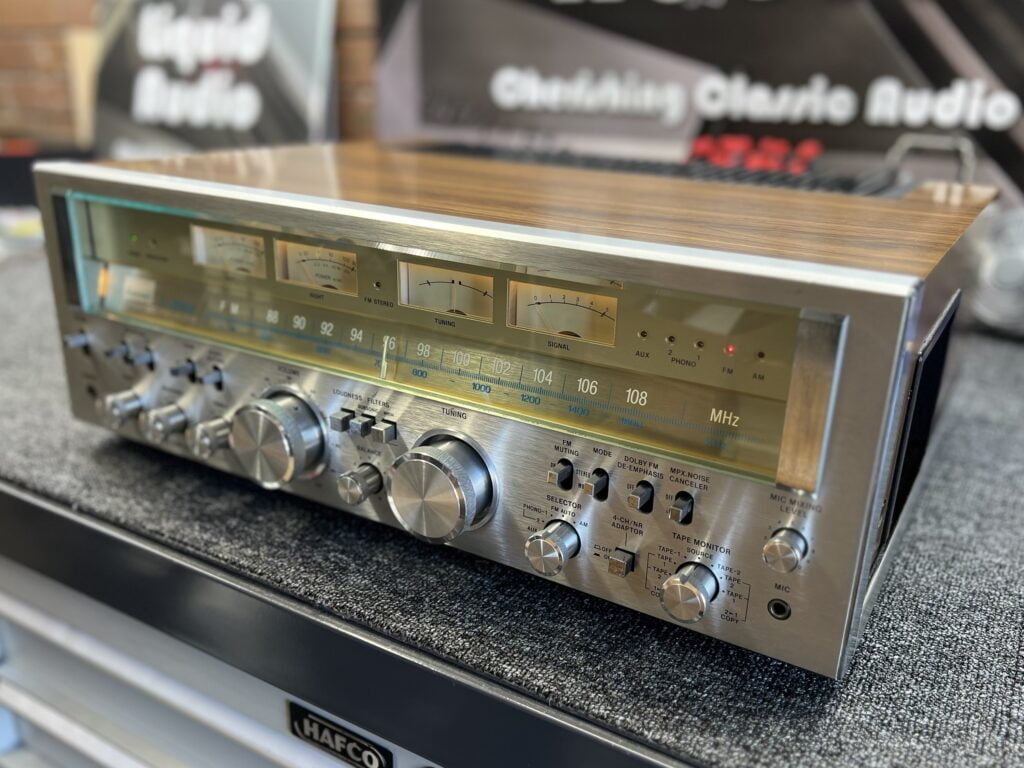

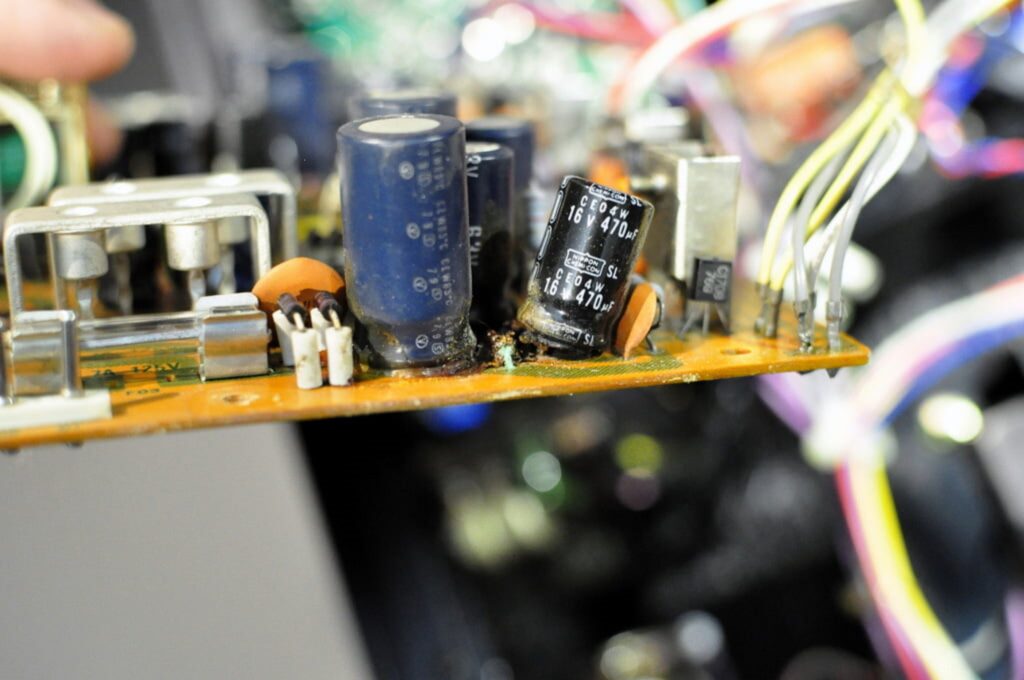
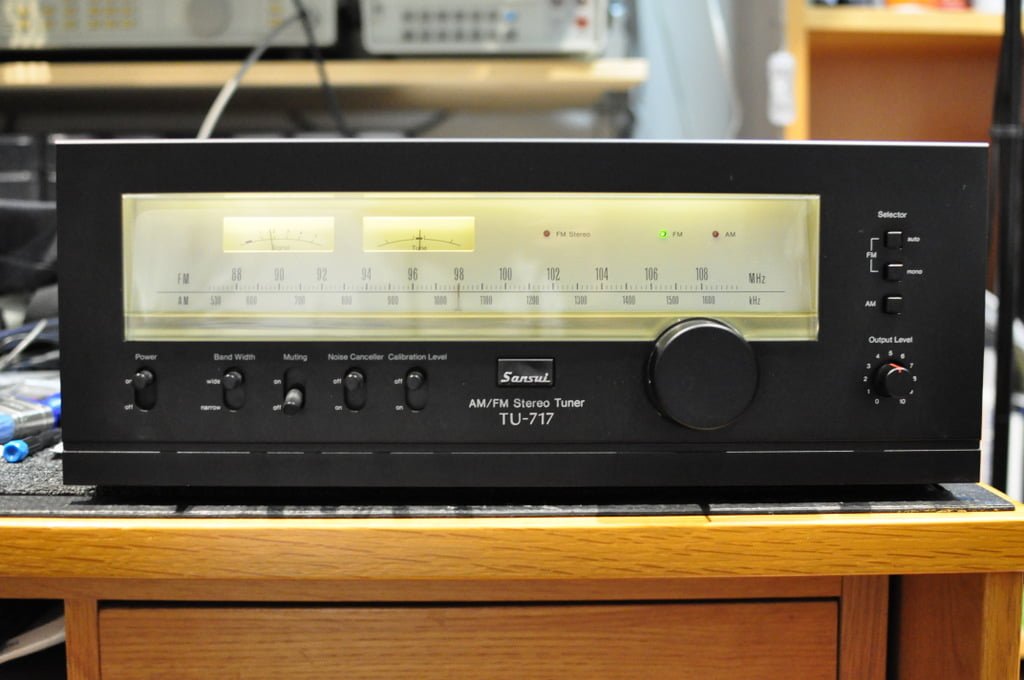
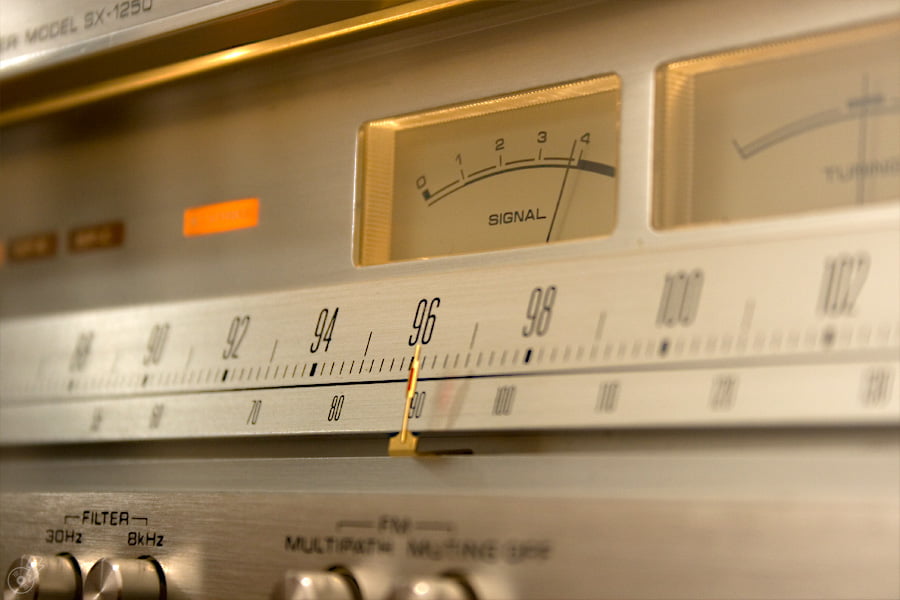

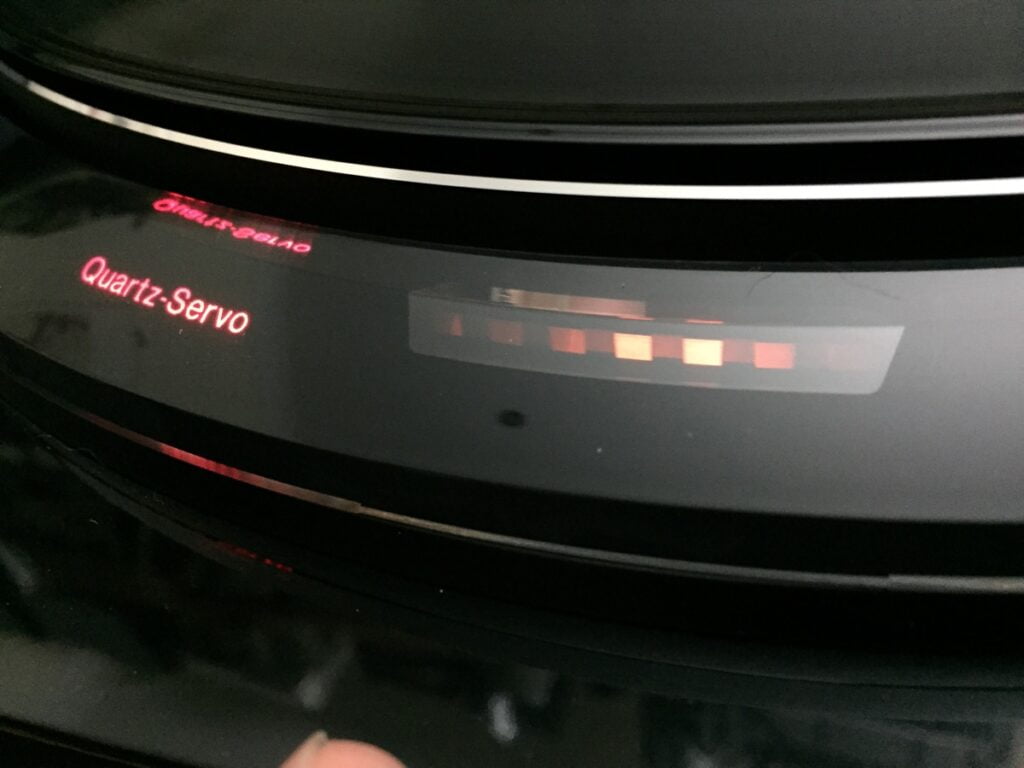
Gotta admire Mike’s love and care for this absolute beast. So pleased and relieved it’s been restored to its full glory and power, and not junked or damaged by someone less careful and knowledgeable. One reads about these magnificent monsters on the US sites without realising just how rare they are in Australia, let alone in this condition. I simply couldn’t fit this flashy monster into my place, but I hope it finds a loving new owner. Like an AMG 6.3 of its era. Bravo and well done Mike!
Thank you Robert. I agree, these really are an unusual find and in such original condition. Very much like an AMG 6.3 as you note, a great analogy, let’s hope I can find her a nice new home!
Hi Mike, it is always good to see a professional do his job, old gear like this deserves to be brought back to its original condition. Keep it up.
The KD600 is still running with a low mass arm and a Sonus Blue, all old gear and it sounds great.
Thank you for those kind words Wolfgang and very glad to hear the KD-600 is still going strong!
Very awesome article on such a beautiful piece of hi-fi. Love pieces of stereo from times gone by. Have a couple of pieces myself, receivers, 8-track, phonographs, combo sets ect.. ✌️. Currently having issues on control knob on volume control, moved and still unpacking
Glad you enjoyed it Rich and thanks for taking the time to leave a comment!